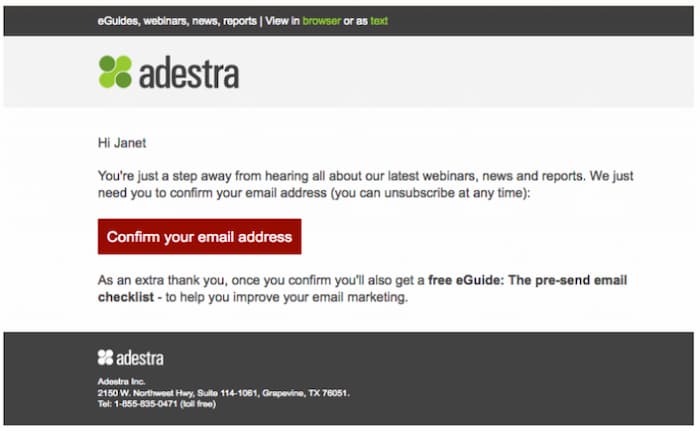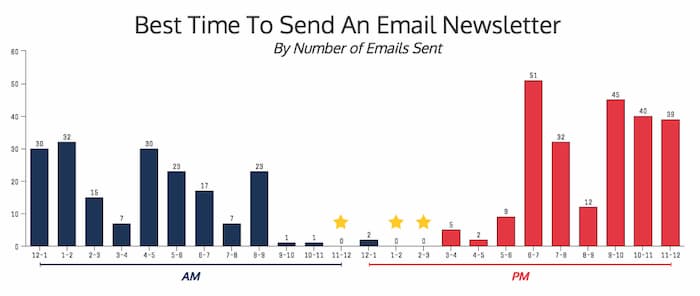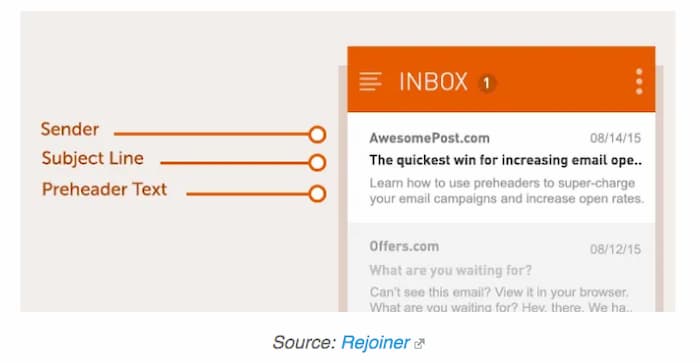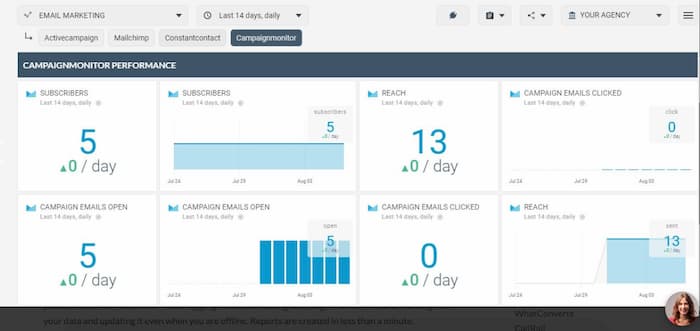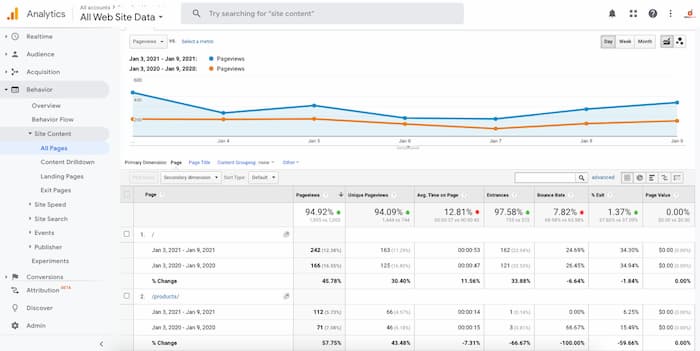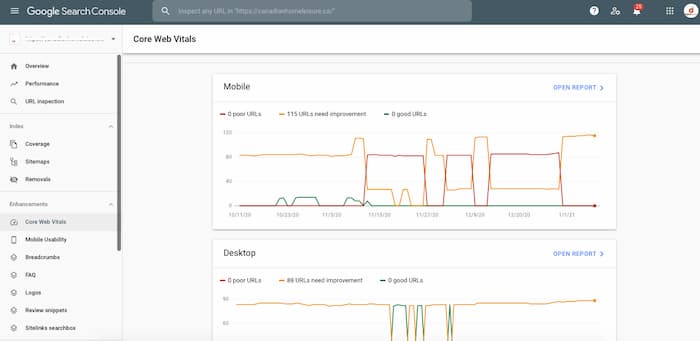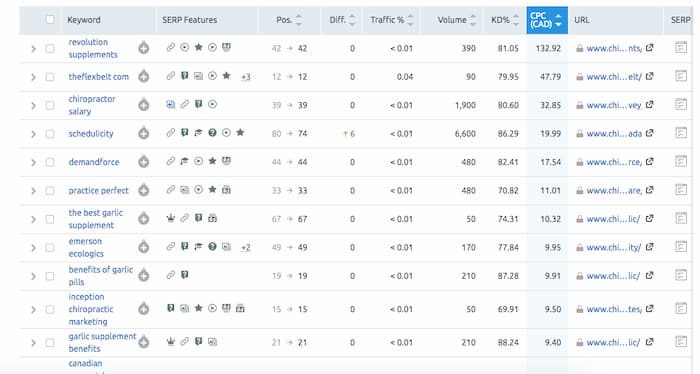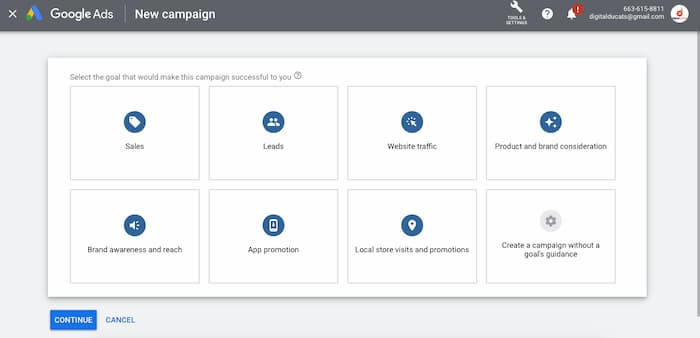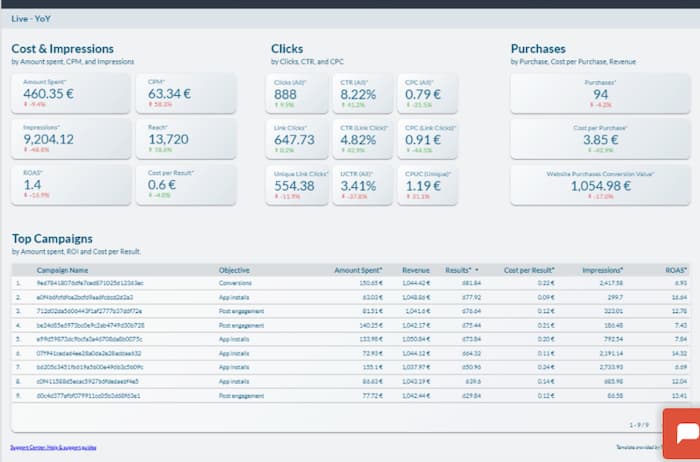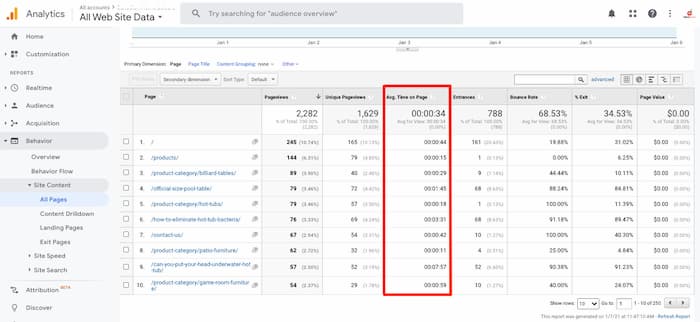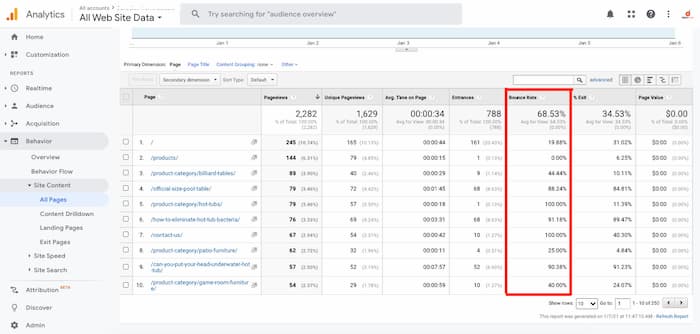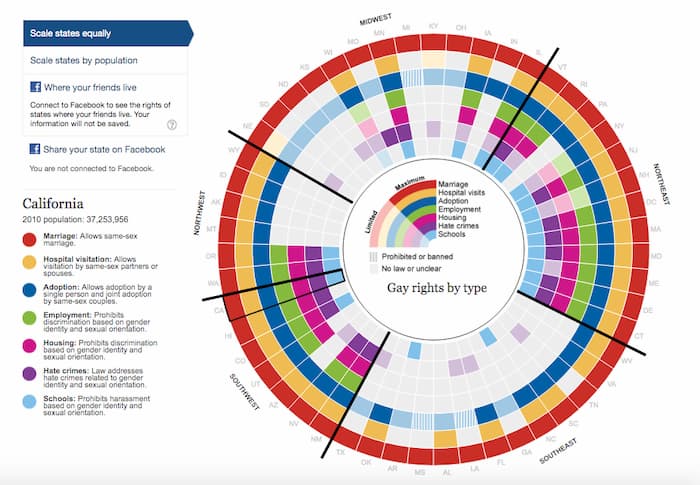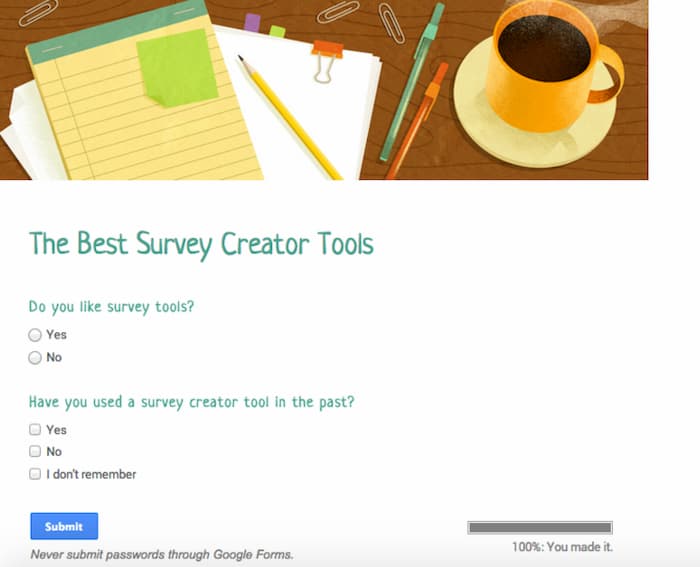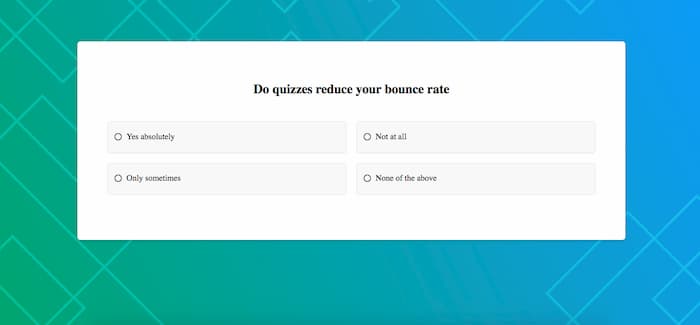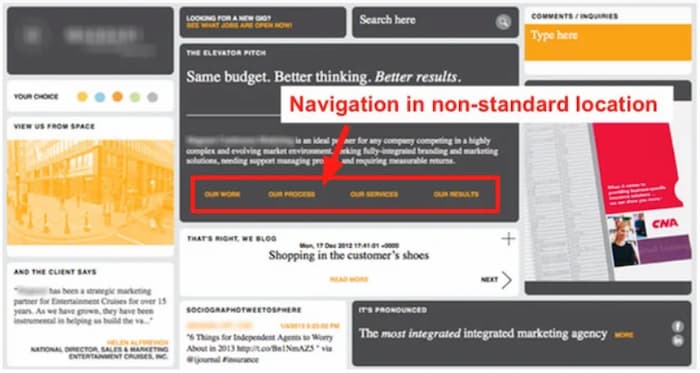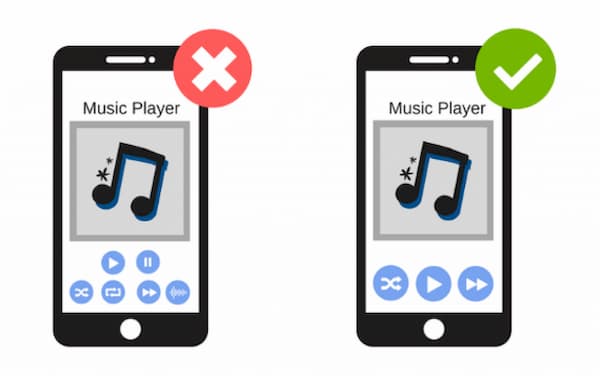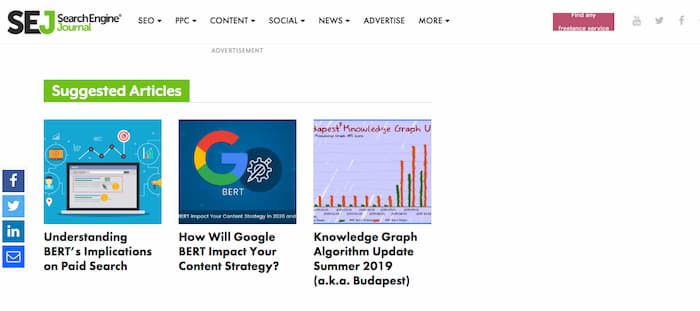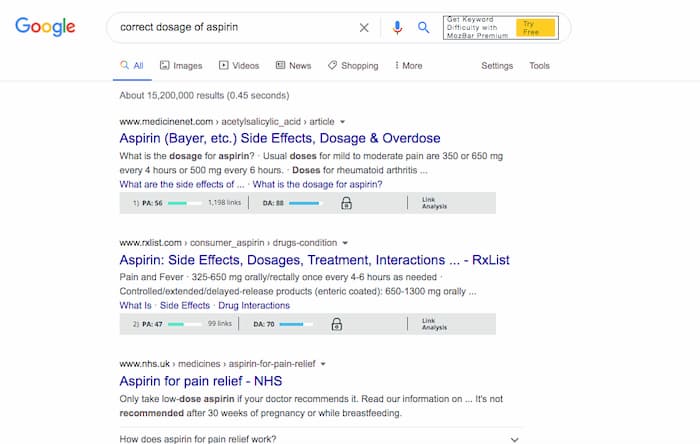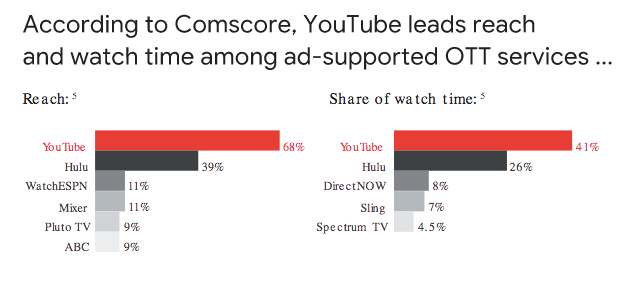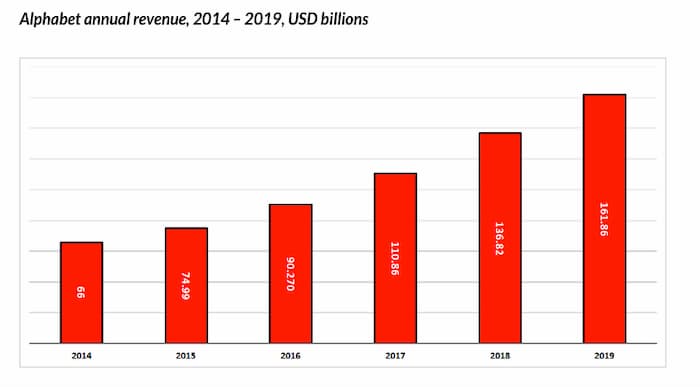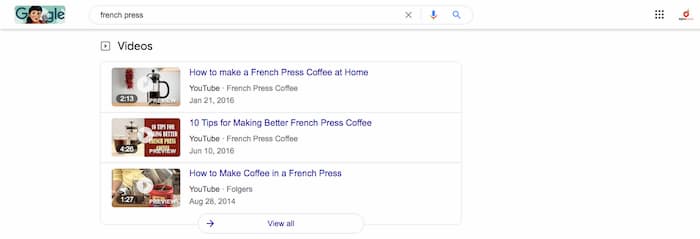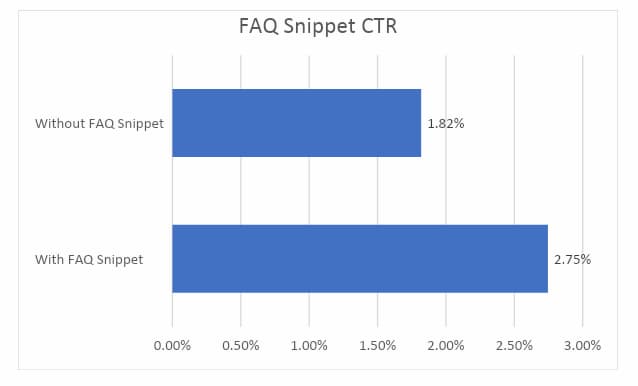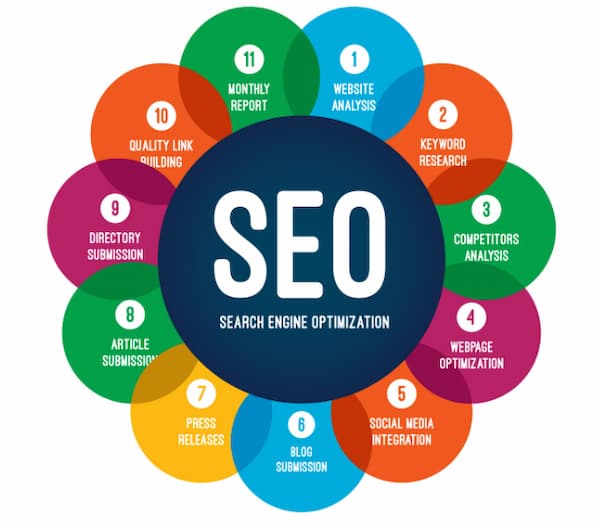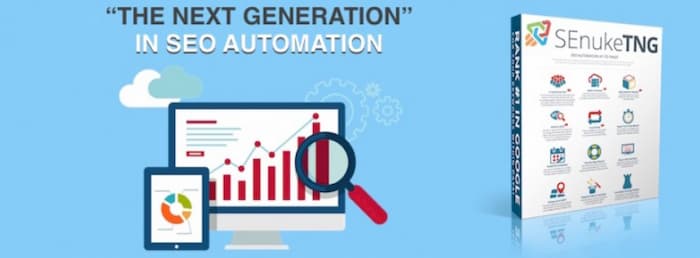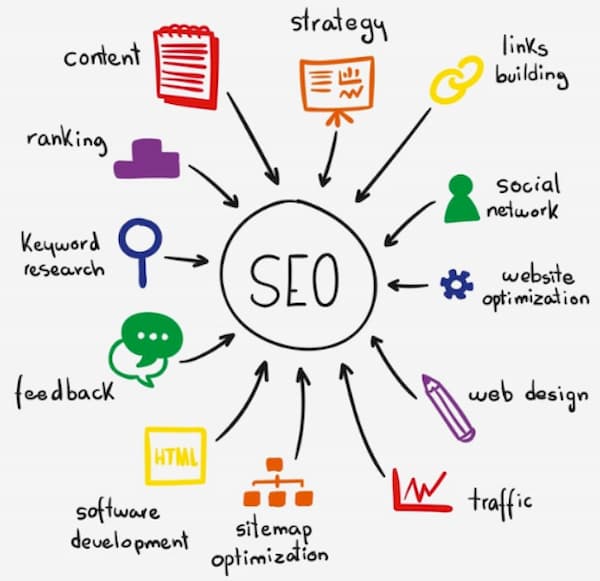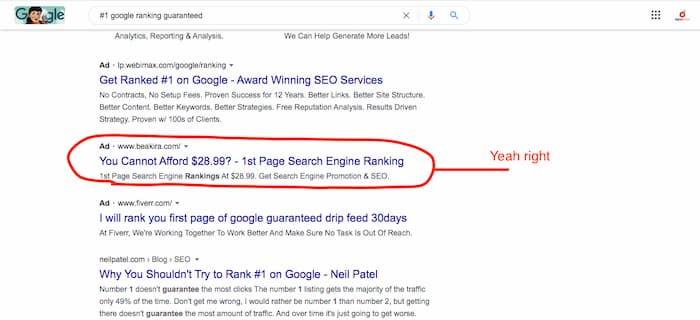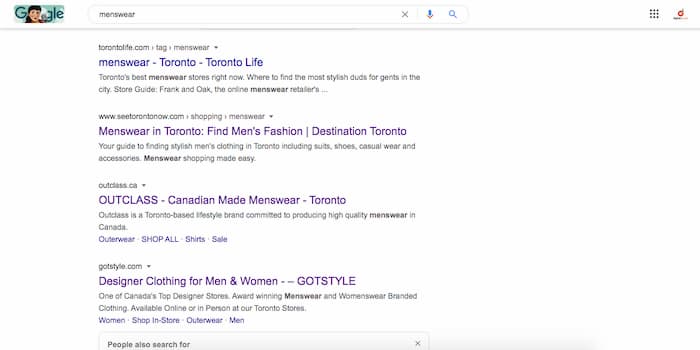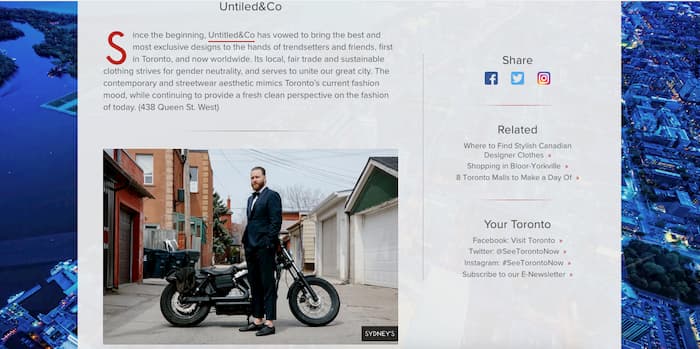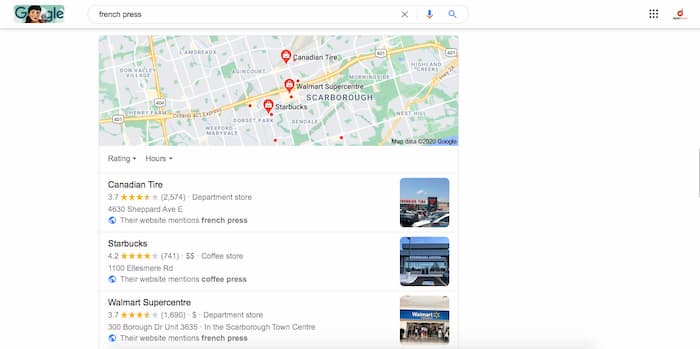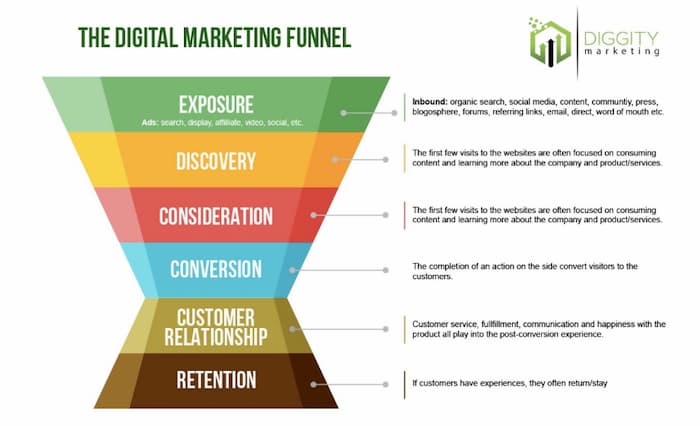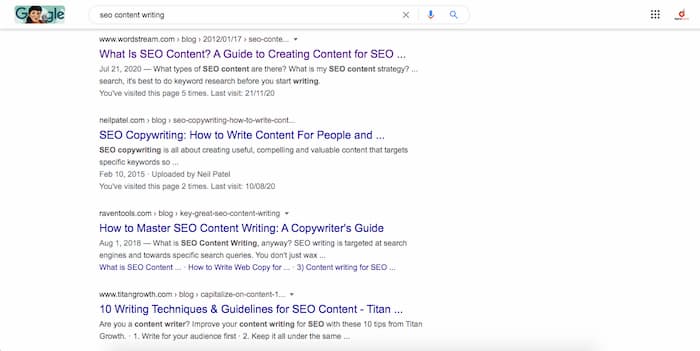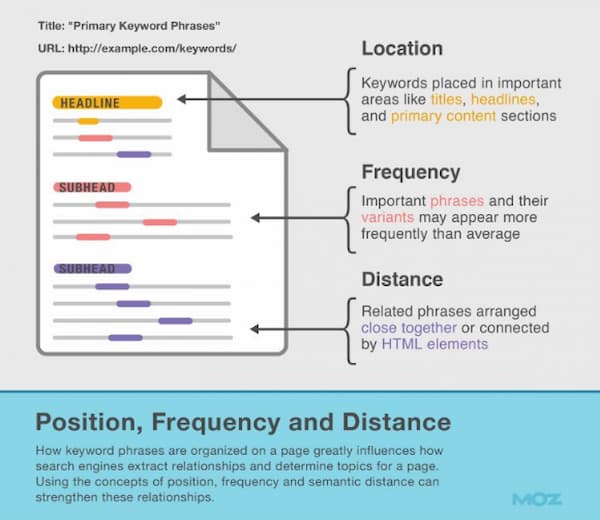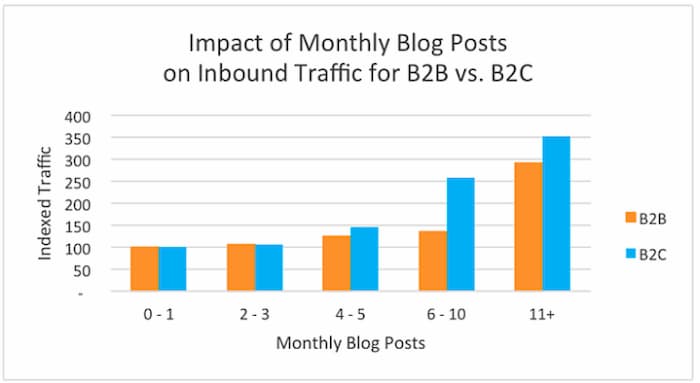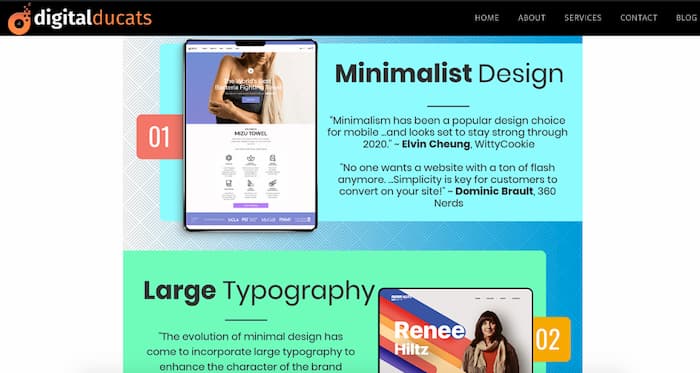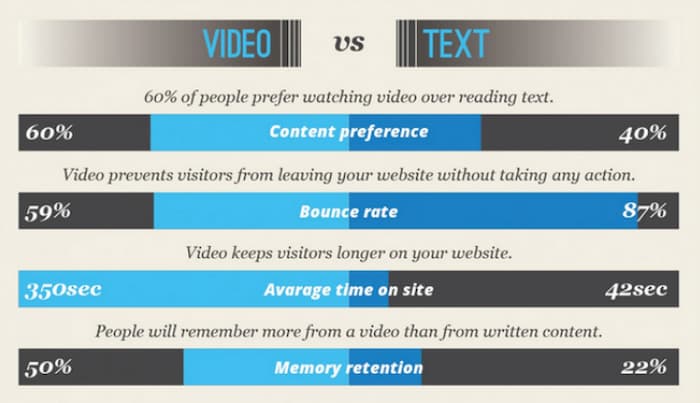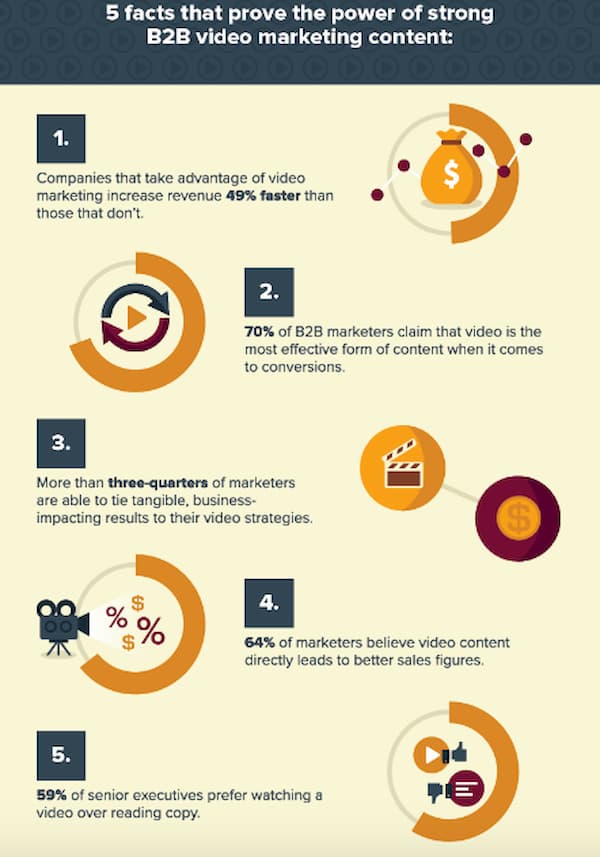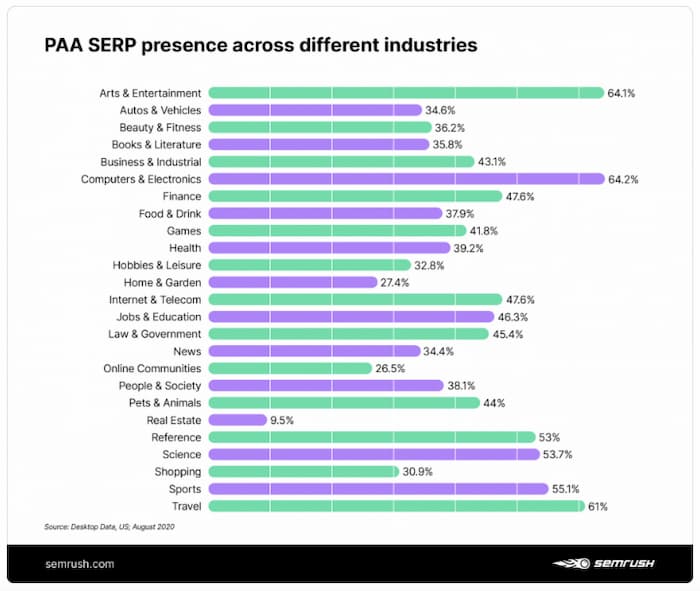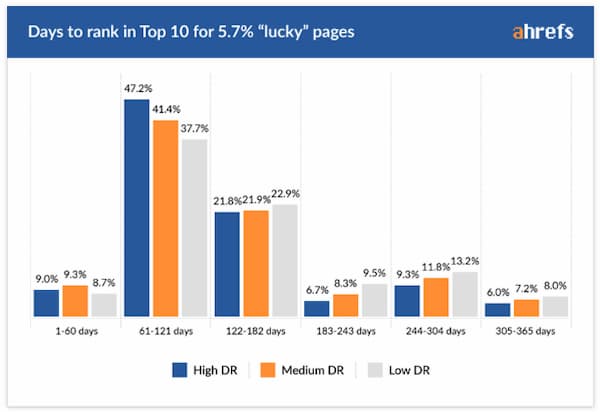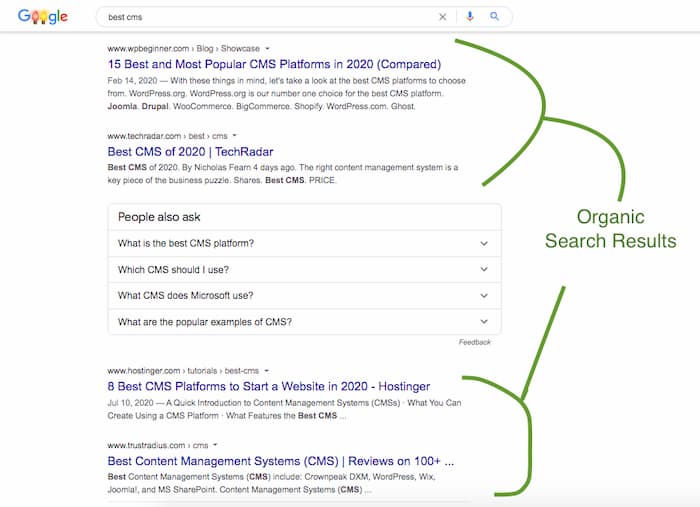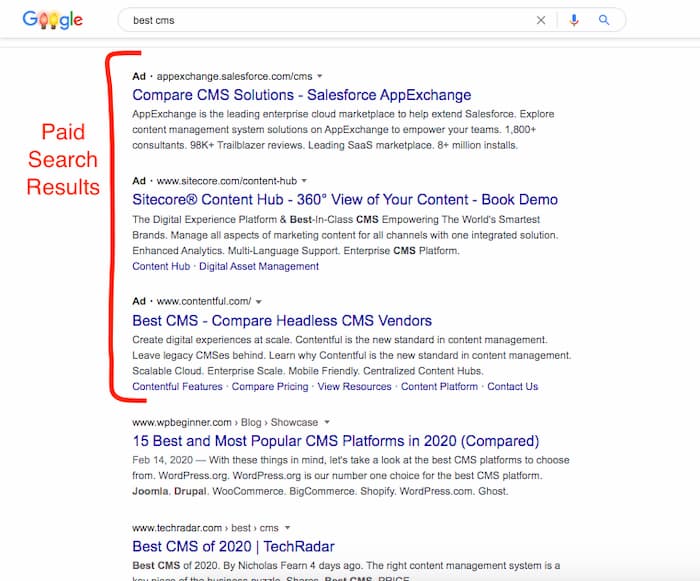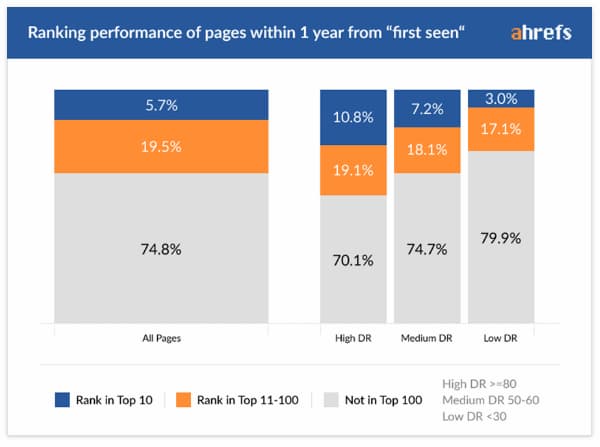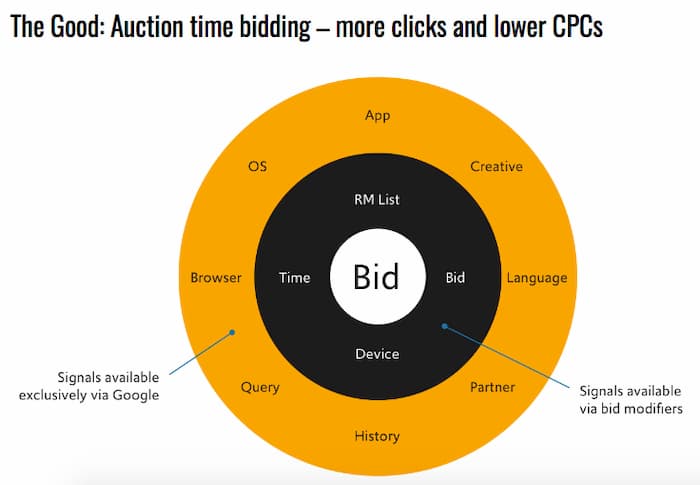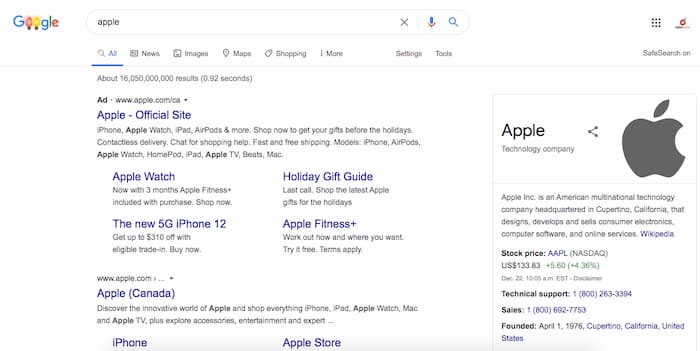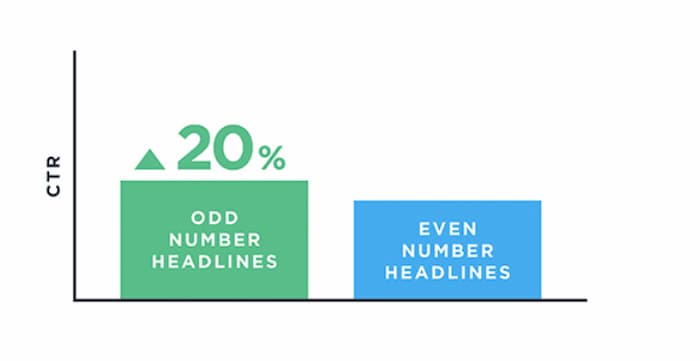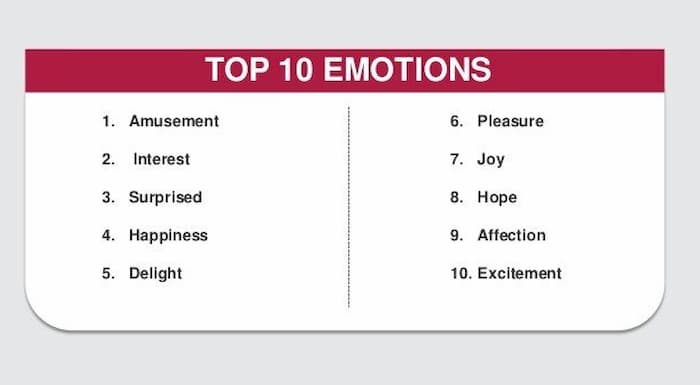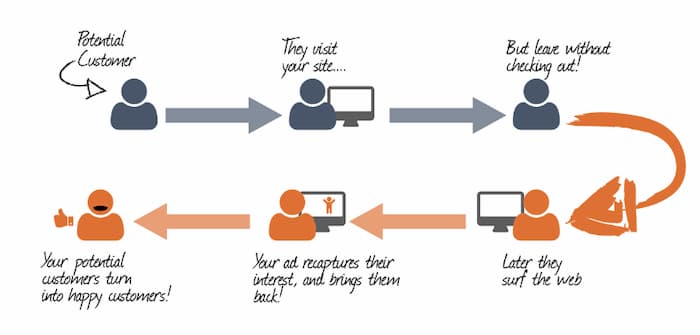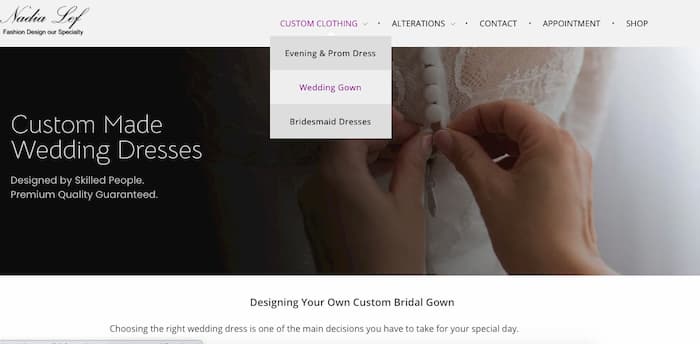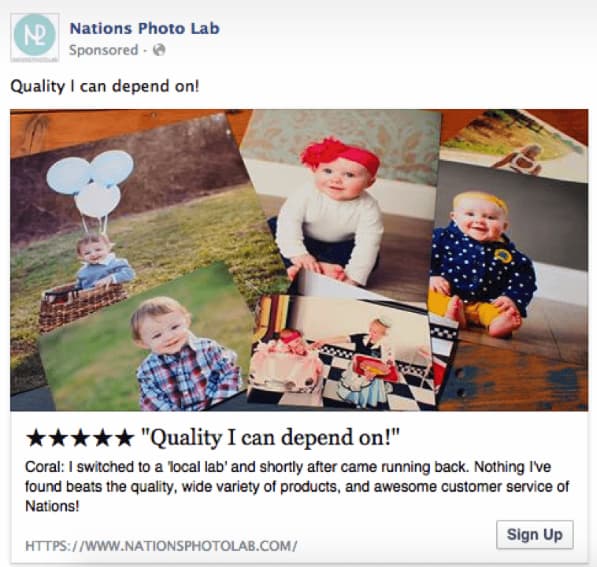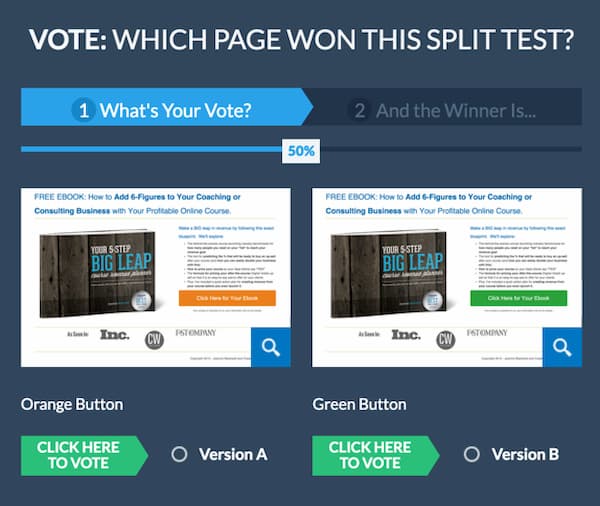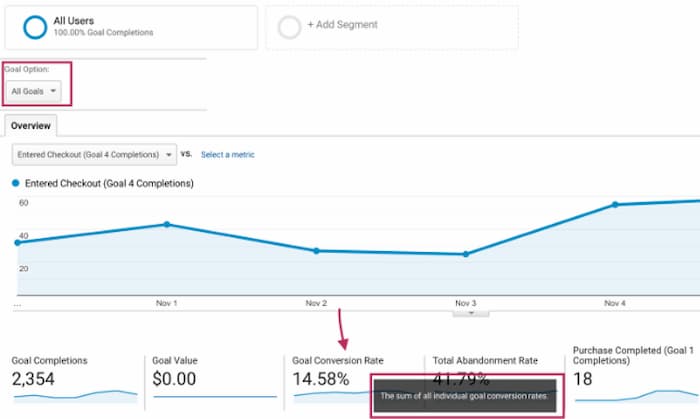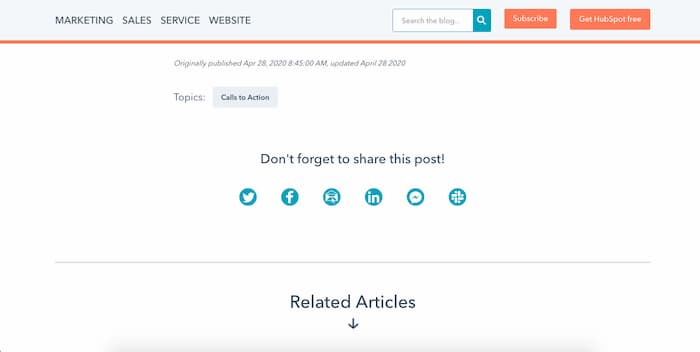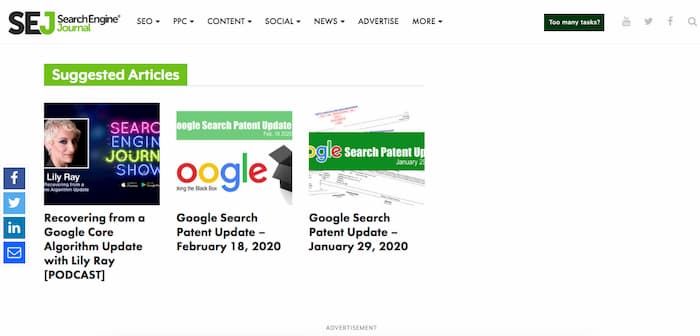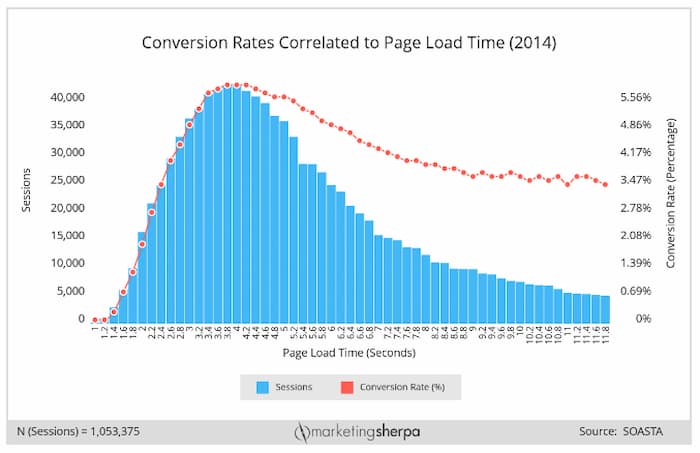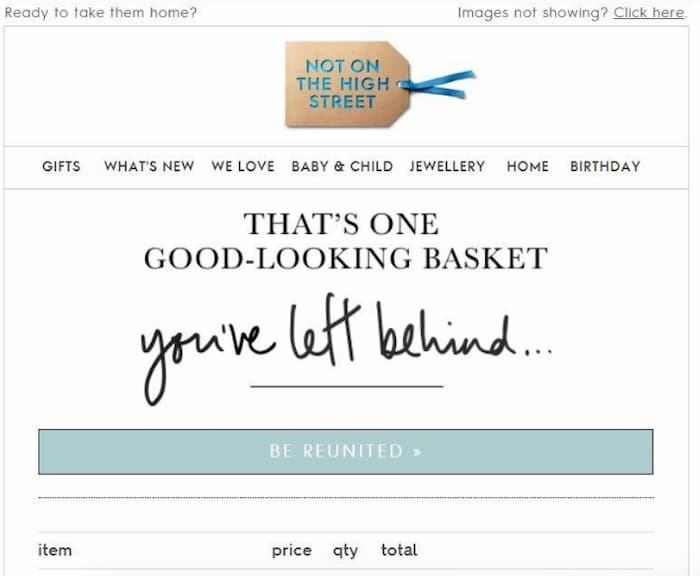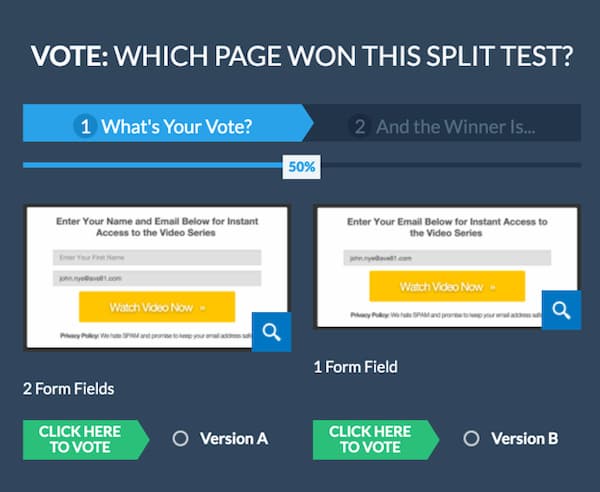Email Marketing Strategies To Increase Engagement
You may be wondering why email marketing has made it this far in the digital marketing spectrum. This strategy is undoubtedly one of the oldest online marketing tactics and you would think eventually, people get tired of it and it would just not work as well. Wrong! Email marketing is just the opposite. With an average of 3800% ROI and one of the best conversion rates in the business, email marketing strategies have evolved to make it more effective than ever.
It’s never too late to start building your email list. Dozens of platforms are fairly inexpensive (free versions as well) to get you started. If you’re planning on scaling up, make sure you’re aware of the options and features that you’ll need as your list gets bigger and demands more management. Automation will be your best friend so plan ahead and in the meantime, here are some tips that will get you that extra-large audience.
- Confirmed opt-in
- Choose the right frequency
- Choose the right time
- Make your email accessible
- Pay attention to deliverability
- Split test your subject lines
- Follow your subject line up with a headline
- Use images and video whenever possible
- Include a CTA
- Include a welcome email
- Publish pages to create a marketing funnel
Use a confirmed opt-in
A confirmed opt-in box requires your subscribers to confirm their email address when signing up for your list. The reaffirms the interest in receiving emails from your business.
Some may think this is a double-edged sword. If you double confirm your subscribers, won’t you wind up with a smaller email list? Absolutely. You wind up with a smaller list of a more engaged and more responsive audience.
A confirmed opt-in keeps your list clean. Rather than have a lot of “undeliverable” emails from the user typing in the wrong address, you have a list of confirmed subscribers. This saves you the trouble of pruning and weeding out bad email addresses and keeps your engagement reports more accurate.
Go for quality rather than quantity. Use the double opt-in for less headache and a more responsive audience.
Choose the right email frequency
Are you wondering how many times a week you should be sending your list an email? The industry averages indicate that once a week is the best frequency for optimal results.
There are benefits to emailing your list more than once a week but they also come with a trade-off. The more you email your list, the lower your open rate becomes. There’s a drop off in engagement as people start ignoring your email after a certain point.
Start with sending an email a week and test whether your audience responds positively when you add one more per week. If you’re getting more traffic and conversions, there’s a positive correlation with the additional email.
If there’s a steep drop off in engagement and your list starts unsubscribing, you know you’ve reached your limit and need to back off with the additional emails.
Choose the right time
Did you know that there’s a perfect time to send an email to each of your list members? Unfortunately, it’s different across the board for people but there are options using software that can help you send email to each of your list members based on historical open rates.
If your provider doesn’t offer this option, stick with the general bell curve for the most success in getting your email to the top of the inbox. If your email is the first one that a subscriber sees, it will have the best chance of being opened.
Make your email accessible
Thankfully, we live in a time of equality and are always looking to make things easier for our prospective customers. Approximately one-fifth of the world population has some sort of visual impairment so you mustn’t exclude this group from your audience.
Make your content accessible by including descriptive alt tags in your images. The alt tags will at least describe to your reader what the image is about.
Many people use software to have their email read to them so make sure you use the punctuation marks within your alt tags. The reader will pause at the appropriate times and make your content more enjoyable for your audience.
Pay attention to deliverability
It’s important to keep track of the email that ends up undelivered. It may not be the provider or a misspelled email address that is causing your email to fall short of its destination. There are multiple reasons why an email is undeliverable.
Check your email spam score to make sure you’re triggering the spam filter. If your email is ending up in the junk folder then it’s time to reassess the content you’re sending and how you’re sending it.
Monitor the open rate, churn rate, bounce rate and complaints. Identifying the underlying reasons for these metrics will improve the quality of your campaigns.
Split test your subject lines
An email list is an excellent place to test the effectiveness of your content. Use split tests to see what subject lines generate the biggest open rates. Identifying what gets the best response from your list will indicate what type of content to continue sending to your list.
Personalization is a major theme in creating successful campaigns. The more you see what triggers responses from your audience, the more you can effectively engage them in your offering.
Follow your subject line with a preheader
The headline that you start your email with should complement your subject line. It’s a way to follow up with the initial message you’re sending to your readers. Emails with preheaders get an average open rate of 29%.
Remember that the content above the fold is the most important part of your email. It’s what will essentially hold the attention of the reader and entice them to read further and scroll to the bottom.
If the subject line was enough to get them to open the email then your headline will help maintain that initial interest.
Use images and video whenever possible
If an image is worth a thousand words, how many words is a video worth? It’s not always possible to send a video with every email but the use of visual content is vital to getting the most out of your email marketing campaigns.
Videos are the most preferred form of content so it remains your first choice above all. Videos increase engagement, conversions and reportedly generate a 13% open rate.
Images are the next best thing to make your email more appealing. People retain 10% of the information from text-only but retain 60% of the content they read when there are images to explain the talking points.
Use both images and video whenever possible to enrich your content and make your message much more memorable. The result is more click-throughs and higher conversions.
Include a CTA
People need to be told what to do. Never assume that they will know exactly what you want them to do so include a call to action to increase the desired action you want your audience to take.
Be specific with your CTA and provide marked links, buttons or forms to get your audience to take action.
Include a welcome email
Always have a welcome email sent to your list when they first subscribe. Welcome emails get the highest open rates providing a big opportunity to communicate with your list.
Welcome emails can give your audience a breakdown of what to expect and provide options on what they can do and what you’re offering. You can introduce your new subscriber to new content and get more out of your list by making sure they receive a welcome email.
Publish pages to create a marketing funnel
Make sure you have pages that will ultimately lead your subscribers to purchase or completing an action. There are emails you can automate to make sure your audience is being guided in the right direction. Here is a list of the forms that will make a difference in converting your visitors to clients.
Use email marketing strategies that make a difference
There’s no excuse for not starting an email list. You have a variety of options when it comes to providers and there are plenty of free services to get you started.
When you want to take your conversions to the next level implement these email marketing tactics and strategies to get a boost in the traffic and revenue your website generates.
Data-Driven Marketing: Invest In Effective Solutions
If you travel back in time to the turn of the century, you would find that in the year 2000 marketing was a very different animal. Most marketing was dominated by radio, television and ad placement in magazines and billboards. Fast-forward 20 years and the bulk of the spray and pray tactics are now obsolete since data-driven marketing has proven to be the best way to increase leads and revenue.
There is a much higher demand for personalization from consumers and a world of data to pull from. In fact, if you’re not appealing to specific desires from your target audience, you’re losing them to other companies.
Today’s consumers are naturally trained to glaze over advertisements. There are so many ads that are in our face every day that it’s become a natural response to automatically close popover, pop-ups and generally skip paid ads to get to the organic results.
This behavioural pattern has given rise to the power of inbound marketing and the importance of becoming specialized in a specific area of expertise.
In order to cut through the noise and separate yourself from the masses, you need to apply data-driven marketing strategies to reach the audience that will engage with your brand the most.
By applying statistical facts to your marketing decisions you can outperform the old methods of operating on gut instinct. This is how companies are increasing profit and successfully expanding their audience.
What is data-driven marketing?
Data-driven marketing gives companies insight into the preferences and behaviour of their target audience based on big data and statistical facts. Companies then use this information to make more informed decisions on the marketing tactics and strategies they choose to employ for increased engagement.
Without measuring the impact of your efforts, it’s difficult to optimize your campaigns to be more successful. When data is collected (preferably from a large sample size) it is then used to increase key performance indicators that will result in more leads and revenue.
Example of data driven marketing
Here’s an example of a data-driven marketing campaign: Assume your company is running a PPC campaign where the target city is Toronto. After one month, you assess the results and notice that the majority of clicks are coming from similar postal codes.
You research the average household income for the areas in Toronto, and find that the majority of the clicks is coming from the postal codes where income is the highest.
Based on the results of your first campaign, your data would suggest that you need a different type of advertisement to get lower income areas to click on your ads.
You would need to cater to the lower income households by creating a more appealing-perhaps one that communicates more savings.
This approach would increase the number of clicks and conversions by simply changing your copy to something more personal and applicable to the demographic.
This is data-driven marketing in action.
Who uses data-driven marketing?
You would be hard-pressed to find an industry leader that isn’t using data to help make informed marketing decisions. Here at Digital Ducats, we use Google Analytics to collect data on visitor behaviour and website performance daily. The more time and visitors that pass through a website, the more accurate the data becomes to make informed decisions.
The data we use tells us where visitors enter your website, how much time they spend on each page and where they leave. Analyzing the flow of visitors on your website allows us to identify the improvements they need to make to keep users on your site longer and guide them to pages that convert at the highest rate.
If there are pages that generate high bounce rates, we find the underlying cause why your website is losing traffic to the page. Through testing and making changes, your website becomes streamlined for conversions and leads visitors to purchase decisions or becoming a qualified lead.
Tools for automation
There are tools to automate everything when collecting data on your business. Depending on what your marketing goals are will depend on the tool you need to employ. Here is a list of tools that can generate useful data for making informed decisions on improving performance.
Google Analytics
The fact that the tool is free is a bonus being one of the most comprehensive solutions for tracking website data. Analytics tracks every major metric you will need to monitor your website’s performance when it comes to user behaviour.
The most commonly tracked metrics are: monthly search volume, unique users, traffic acquisition channels, flow of visitors, average time on page, bounce rate, conversion tracking and more.
Google search console
This tool is the go-to source for everything that’s happening with your website behind the scenes on Google. As an owner, you are entitled to a free account and can access website performance data such as impressions and clicks to every page.
Core web vitals will officially become a ranking factor in May of 2021 so there is the importance of being alerted to any changes, errors and improvements that need to be made in this department.
You can connect your search console and analytics account for more streamlined and accurate reporting.
Analytic keyword tools
Every SEO company will use a few different tools to provide the best scope and range of information when making decisions on keywords and competition. SEMRush, Moz and Ahrefs are among the top industry leaders for providing access to valuable keyword data and assessing the competition.
Not only do these tools provide keyword generation ideas, they generate loads of information that come with each suggestion to allow greater insight into the keyword.
Information about the level of competition, the average monthly searches, the cost per click, the level of competition, the organic click-through rate and the SERP features that the keyword triggers.
Most of these tools also provide intensive competition analysis allowing you to see what keywords your competition ranks for and the volume of traffic they generate. You can see whether they are paying for traffic as well as the backlinks that point to their web pages.
No SEO campaign would be successful without being able to formulate informed decisions based on the information provided by these types of software.
Google Ads
Running a PPC campaign generates an enormous amount of valuable data that can be used to create more successful marketing campaigns. The detailed creation of PPC campaigns coupled with the amount of data that comes back in the reporting can speak volumes about your target audience.
PPC campaigns provide volumes of data regarding the user behaviour and how they respond to your sales copy, landing pages and products.
What’s more, is the data that is returned can help you build more accurate buyer personas for more effective content and targeting.
Email marketing software
Email marketing software provides you statistics on the success of your email marketing campaigns. Use this data in conjunction with your Analytics to segment your lists and create more personalized content for your audience. You can use tools like Mailchimp, Aweber, Get Response, Campaign Monitor or any you deem worthy.
A simple metric like the open rate can provide you insight into the effectiveness of a subject line in an email. A high open rate would indicate your audience is responding to the topic and delivery of your subject line-which makes it ideal to use variations of it as a title or headline for a blog post or article.
A high click-through rate of an email would indicate the body of content is appealing enough to get users to read further. This gives you a proof of which topics to pursue and build more content around to maintain high levels of engagement.
Tips to create a data-driven marketing campaign
Here are a few tips for creating campaigns that continually become more effective in targeting your audience and more optimized for conversions.
Create a well defined goal
Define the goal that will create a competitive edge in your marketing. You need to have a major objective in your campaign with a clear set of values you can walk away with and use in your next campaign. A clearly defined goal will keep you on track and provide a specific benchmark that can be measured for effectiveness.
Select your tracking tools
Choose the tools that will give you the data you need to make better decisions in the marketing campaigns that follow. Make sure you’re setting up your campaign with the tools that will give you the most accurate values for achieving your objective.
Setting up analytics means creating conversion goals and trackable links to see what’s actually happening on the pages you’re testing. Without using the proper tools your values can be skewed so make sure you’re getting the most from your campaign by using tools that will provide the metrics you need.
Incorporate data from past campaigns
Always make use of previous data to make informed decisions. If you’ve already run a campaign that has presented a set of data, incorporate that data into your next campaign. This creates a more effective, optimized campaign.
Use data-driven decisions to increase your bottom line
Use as much information about your products and consumers as possible to create highly targeted marketing campaigns. The demand for personalization has been made clear and it’s up to you to meet the demands of your ideal audience.
Applying data-driven marketing strategies are the norm for creating the means for more informed decisions on your marketing campaigns. Make use of statistical facts about your audience to see more engagement, leads and revenue on a regular basis.
9 Ways To Reduce Your Bounce Rate & Improve Traffic Quality
Of all the ways to increase traffic to your website, it’s not often that you think of the source of new visitors as being from the traffic you’re already receiving. There’s a hidden trove of visitors you can unlock by using several tactics to reduce your bounce rate.
What is a bounce rate?
The bounce rate on your site is the total percentage of visitors that land on your site and leave without interacting with any other pages or links. This is a metric that’s reported in your Analytics and a value that can be crucial in improving the quality of traffic your website receives.
You can find the bounce rate of the pages of your website in Google Analytics by clicking on Behavior,
Used in the right context, this metric can identify problems on your website that may be causing people to leave.
A high bounce rate can potentially indicate a missed opportunity since visitors are already on your page and yet leave without completing a goal such as making a purchase or signing up to an email list.
Related reading: Key Performance Indicators & Data Analysis
What’s a good bounce rate?
A good bounce rate can be different on a situational basis. Many site managers would maintain that a bounce rate of over 60% warrants attention. Others are happy if their bounce rates are under 80% and yet this could be a catastrophic number to another website.
The percentage of a good bounce rate depends on the niche in which you’re competing and the type of page that’s generating your data.
So where is the happy medium for your website?
Your bounce rate should be assessed in light of the goal you have for the user on the page you’re analyzing.
You also need to accurately determine the behaviour of your audience to understand the meaning of the data being generated.
Aim to see the bigger picture
The problem with using bounce rate alone is that it doesn’t give you the entire story of what’s happening on your website. In the words of Dan Shewen,
[bctt tweet="No metric is an island on its own."]
If a user lands on your page and reads every single drop of a 5000-word article, then leaves, it would technically register as a bounce. If 80% of users did the same thing, the first glance at your analytics might tell you visitors do not like your content-which, in reality, this is not the case.
This brings us to the first point…
#1- Reference the average time spent on page
To accurately determine the true meaning of bounce rate on a specific page, you need to compare it to the average time spent on the page. In the example above, the bounce rate alone is a misleading metric without cross-referencing the average time spent on a page.
Significance of longer averages
By recognizing that each user spends 5-8 minutes on your page before leaving paints a more accurate picture of how users are engaging with your content. You can’t be certain that your content is the problem judging from just the bounce rate and not referencing the average time on the page.
If people are spending a long time on your page, it means they’re getting through your content. Consider creating a conversion goal, call to action or offer more options for related content to get them clicking through your site (discussed further in this article).
Significance of shorter averages
A short time spent on your page could mean users aren’t liking what they or they aren’t getting there because your page takes too long to load. If the average time spent on your page is short and you have a high bounce rate, you need to make changes. Users are landing on your page and not even giving it a chance.
Significance of no time on spent on page
If the page in question shows no time spent, the user might have closed the tabs or the browser to end the session on your page. If this happens, there is no time recorded because there is no exit click.
The average time on a page is measured from the entrance click to the exit click. If your users don’t click on anything and close the tabs you have some slightly misleading data being generated.
#2- Establish a CTA or conversion goal for your page
Content alone is not enough to keep visitors from leaving your page. Establish a clear and concise call to action for each of your pages to keep your audience engaged and moving through your website.
Ask visitors to share your content
Are you trying to build a stronger social presence? Ask your visitors to share your article with their social networks. Social sharing plugins are effective and offer a simple click to share option, making it easy for readers to click on the icon and share with their audience.
Ask visitors to join your email list
Present your readers with more opportunities to join your email list.
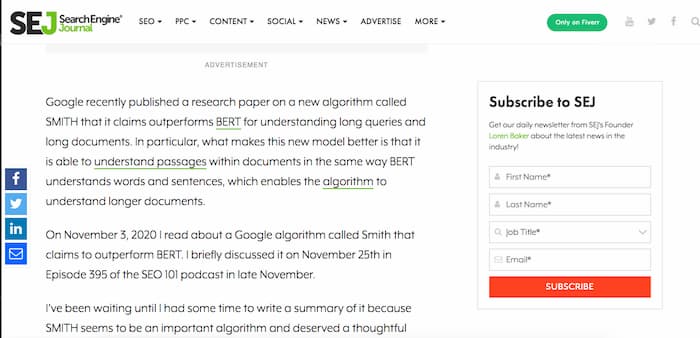
Include a CTA a few times within your post, which can be on the opt-in form itself.
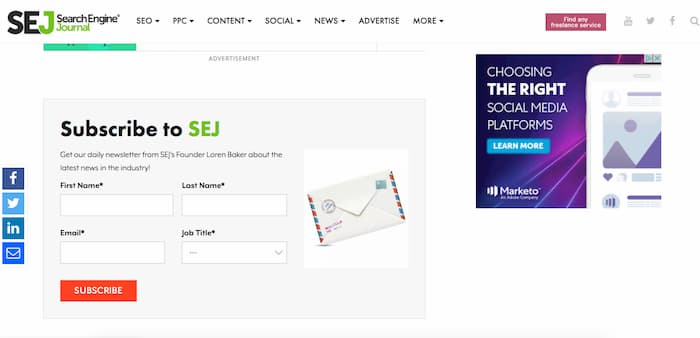
Create conversions on Google Analytics
Ultimately we want our website visitors to purchase a product or service from our business. Creating goal conversions tracks whether your audience is doing what you want them to do on each page.
Whether it’s a sale, email sign-up form, or a social share, track your goal conversions. When your visitors start clicking on the links you want them to, it eliminates the session from becoming a bounce.
#3- Use interactive content
In the case where users are landing on your pages and leaving almost immediately, you will need to consider updating the content on the page. Interactive content is a solution to get your audience more engaged with your page and improving the stickiness it has for captivating their interest.
It’s a proven fact that people learn more when they are engaged with hands-on learning as opposed to just reading or listening. Interactive content allows your users to elevate the learning curve and retain more information. By getting your visitors to engage with any of several different content assets, you can reduce the bounce rate of your pages.
Interactive infographics
Infographics may have seen their height in popularity, but they are beneficial for both B2B and B2C sales and marketing. Visual content itself is proven to improve retention from 10% with plain text to 65% with an image. Interactive infographics boost information retention to the next level by allowing the user to interact with the graphic.
Here is an example of an interactive infographic that shows you information on the gay rights of each state in the US.
Whichever state you hover over with the mouse will highlight the information from that state on the sidebar.
Surveys
Surveys are proven to be one of the most popular forms of content. Incorporate a survey within your content to get your visitors engaged.
You can choose from some of the most popular survey tools as a starter for testing out your audience’s response.
Polls
Inserting polls within your content also gives your audience a fun way to answer questions and compare their answers to past visitors.
Inserting a poll in your content can provide a good break-in text and get your visitor to actively participate and engage with your content.
Pop quizzes
What better way to reinforce the content your visitor has just read than a pop quiz? The response from your audience may vary (some people don’t like to be tested!) but again, it’s a good way to make an option for a user to step outside of the mundane practice of reading and participate in a potentially enjoyable experience.
You can use sites like quiz maker or better yet, Jotform’s Quiz Maker to create and publish pop quizzes in your content.
Click to tweet
Inserting tweets a click to tweet call to action is a simple way for your audience to tweet a message or something worth sharing on your site. The amount of effort required for a user to click on the link makes sharing super simple.
This type of embed serves as a way to break up the text, get your users interacting with what you’re saying and contributes to increasing your audience.
#4- Re-optimize for user intent
When a visitor lands on your page, you have a few seconds before they decide whether your page can satisfy their search intent. Re-optimize your content to enhance your page’s ability to satisfy the user’s intent.
"Give the people what the people want."
The adage, “SEO is ever-changing” applies here when it comes to updating old content. Search intent is constantly in flux and going over old content can reveal out-dated articles that need to be re-optimized for current keywords as well as new ones.
SEO is not static with regards to the fact that at its core, it is based on user intent. People are always changing the way they search for things as well as the language they use to search. It can pay off in dividends to go over old content to make sure that your content satisfies user intent.
Improving the quality of your content and making sure it’s up to speed with the competition improves traffic and will reduce your bounce rate.
#5- Simplify your website navigation and searchability
One of the most common reasons users leave a website is because it’s not easy to navigate. When a visitor lands on a site for a specific reason, they need to believe that your website can satisfy their search. It’s important to provide easy access to all of your important pages so users can find what they’re looking for.
Even if they don’t see what they want at first glance, give them your best options to entice them to click further as well as a search box to search the website for something specific.
Avoid confusing menus and heavily cluttered pages. The actions a user takes on your site should be intuitive and laid out for the easiest and simplest understanding.
Use communicative image icons and a simple navigation bar to encourage more clicks. Think of using the signpost analogy to guide users in the right direction. Drivers need to see signs that communicate clearly what direction they want to take.
Simplify everything and when you’ve got some results and feedback, simplify it again. The easier your site is to navigate the better the UX experience is, which contributes to a reduced bounce rate.
#6- Reduce the time it takes your pages to load
Page speed is talked about repeatedly in almost every SEO article but it’s mentioned for good reason. Google reports that for every second it takes your pages to load you risk losing more visitors.
Some websites have more to gain by improving page speed. If your website is experiencing load times over 10 seconds you have a big opportunity to optimize your page speed to 5 seconds and cut your bounce rates in half.
The result would be the same as doubling your traffic when you consider that you’re now getting the visitors that choose your site already but would never make it with slow loading pages.
#7- Optimize for mobile screens
If you’re not optimized for mobile screens, you risk visitors leaving your site. Reduce your bounce rate by making sure your website is easy to navigate with a layout that’s easy to use on all mobile screens.
Have you ever tried to use the desktop version of a website on a smaller screen?
When users are forced to “pinch” the screen to zoom in and out to read text or use buttons it’s considered to be a poor user experience. This can cause visitors to flee in search of a website that better accommodates their screen size.
Apart from reducing your bounce rate, you may also get a boost in traffic if you’re able to improve your mobile-friendliness. Don’t forget that Google indexes the mobile version of websites before the desktop version.
You can test your website’s mobile-friendliness on the mobile-friendly test site or directly from the SERP.
#8-Link to related content within your website
Use a topical internal linking strategy to provide links to other content within your site that a user may be interested in reading. Not only does this optimize your pages, but also you can lead users to different areas of your site for continued learning and discovery.
If the page your visitor lands on has zero links on it, where would your users go next? The only way out is backwards which registers as a bounce.
Offer related reading within your content and at the end to encourage a higher click-through rate and reduce your bounce rate.
#9- Write long-form content
The advantage of being an engaging writer is that the more you write, the longer people stay on your page! Long-form content also gives you more opportunity to link to related content and direct traffic to product pages and other important pages on your site.
When compared to short-form content, the long-form gets visitors to stay on your site longer and reduce your bounce rate.
Increase traffic with a reduced bounce rate
Reducing the bounce rate on your site could be the key to unlocking a significant percentage of traffic that you already receive. In many cases, the bounce rate represents users that find your website but never make it to see a single scrap of your content.
Deducing the reason for a high bounce rate on your site is a priority that you can’t afford to ignore. Fixing the underlying cause can result in higher user engagement, increased click-through rates and more conversions.
As the competition becomes stiffer and the organic click-through rate dwindles, finding ways to improve the quality of your traffic will be a key element for sustainable growth and increased revenue.
If you have any questions about how to reduce your bounce rate, feel free to contact us for complimentary website analysis and learn how we can help through using custom SEO services.
How Does The Google E.A.T. Algorithm Impact SEO?
Search engines display web pages based on multiple ranking factors and specific set criteria defined within its algorithm which changes with every query. The underlying criteria for assessing quality is based on the Search Quality Evaluator Guidelines that was published in 2013. The guide defines the principles behind the Google E.A.T. algorithm which continues to play a more integral part in Google’s ranking system.
What is E.A.T. in SEO?
E.A.T. is an acronym that stands for Expertise, Authority and Trust. A page that can demonstrate these qualities at a high level is considered to be of high quality. Understanding how to demonstrate these qualities to Google and other search engines can improve your website’s search visibility.
Expertise
This aspect refers to the author’s experience or credentials and how it contributes to their expertise on the topic being published. Expertise can be defined as awards, occupation, experience or accomplishments that are relevant to the topic of the main content.
Authority
The authoritativeness refers to how recognized the website or author is in their field. Do others mention them in the same niche? Are they well-known within their industry and considered to demonstrate thought leadership?
Trust
How well can the website be trusted? Does the website provide security for safe browsing or give a user the confidence to input personal information? Trust signal refers to the means for providing a user with security when browsing the website or interacting with the website.
These three attributes of a web page combine to form the basic principles of E.A.T. and the foundation of assessing the quality of a page.
Why is E.A.T. important?
A search engine function is to display the best solution to a search query. It should come as no surprise that part of this function is to filter out low-quality results and only display high-quality results. To make your website displayed frequently for important search terms to your business, your website needs to communicate the E.A.T. principles where they are most appropriate.
As search engines become better at applying the many different variables that make up a quality web page, the E.A.T. principles will have more impact on your website’s search visibility. Improving these attributes will contribute to higher rankings from increased traffic generation and ultimately increased streams of revenue.
Who does E.A.T. affect?
Technically, the E.A.T. principles affect every website, although it plays a much bigger role in the search visibility of some website over others.
Website’s with subjective content
For example, if a query is made on worlds cutest pets, E.A.T. won’t play as big a role in the search algorithm because the topic is fairly subjective. There isn’t as great a demand placed on a website to prove expertise, authority or trust when providing subjective or entertaining content compared to something that could impact a person’s life.
Does E.A.T. still, play a role in search visibility for subjective content? The short answer is yes. There is still the matter of providing a safe browsing experience and even backlinks that will affect ranking (trust and authority). In this example, however, expertise isn’t really a factor as much as the content itself and how users perceive its value.
Website’s with objective content
When a search is for a recommended dosage of a type of drug, then it becomes a more serious topic. The answer requires a specific level of expertise in order to be reliable and safe instructions for people to follow.
Search engines don’t want to display a search result that could potentially have false or misleading information that could potentially harm someone.
Websites that affect Your Money Your Life (YMYL websites)
Google rolled out the Medic Update in 2018 specifically to target websites that publish content with the potential to impact people’s lives seriously. These sites were referred to as YMYL websites (Your Money, Your Life). The result of the update was devastating for YMYL websites that did not demonstrate the E.A.T. principles.
Below is an example of a website that lost more than 50% of its traffic because it did not demonstrate the proper E.A.T. required for a blog that published health related content.
You can read more about how this website not only recovered its traffic but gained much more by applying the principles to match the Google E.A.T. algorithm.
YMYL websites publish content on topics such as health, finances and any information that affects the well-being of a person’s life. Articles that offer a recommended dosage-even with something as simple as aspirin is now a topic that can only be answered by a doctor.
Here is a search result for the phrase correct dosage of aspirin in which not a single website is listed that doesn’t demonstrate high levels of expertise and authority.
Offering a solution on how to reduce your debt or improve your credit is another topic that should only be published by a professional. Misleading information published on this content could potentially cripple a person financially. The Medic Update now requires searches regarding financial advice to be backed by experts and professionals.
The principles of E.A.T. affect all websites, although there are different degrees in which it affects a websites search visibility
How is E.A.T. applied to ranking?
The Search Quality Evaluation Guidelines outline the specifics on how the quality of a web page is determined. This guide provides a basic structure for what is required to meet the needs of the user and offers examples of web pages in different niches that demonstrate high E.A.T.
The problem
Although E.A.T. has been around since 2013, Google and other search engines struggled with a way of applying these principles within their algorithm. Many of these concepts are fundamentally human making it difficult to create an algorithm that could accurately assess content by applying the same concepts.
The solution
Google’s solution was to create many smaller algorithms tailored to specific niches that could identify the specifics of what was deemed quality.
Once the engineers have a potential change they want to implement, they will show the results to a team of quality raters both with and without the changes to the algorithm. The team is not informed on which set of search results is from the new algorithm.
The raters will then provide positive or negative feedback on the new algorithm search results. If the reviews were positive from the new tweak to the algorithm, Google will implement the change.
How do you improve the E.A.T. of your website?
Keep in mind that every niche may have a different set of values that impact ranking more than another. There are a set of guidelines that are outlined clearly in the search quality evaluator guidelines.
The key to understanding what’s most important is to think of the user first and what would make their experience better. Here are a few of the general practices that will contribute to a higher E.A.T. rating for your website.
Communicate expertise
If your website deals with YMYL content, there is no option but to prove what credentials and expertise the author of the content has in their field.
Publish a detailed About page
For example, if you are the only author on your website that deals with medical advice, you will need to have a strong About page that states your qualifications.
Tell users and search engines why you’re qualified to write about the content you’re publishing by stating your degrees, years in the industry, name of your practice.
List your achievements, awards and notable accomplishments or acknowledgements by other credible sources. Publishing these types of details signals to search engines that you have the expertise required to publish this type of information.
The same holds true for other websites in every niche. The example used in the Quality Search Guidelines uses the About page from a fish and chips restaurant as an example of a small business web page showing high E.A.T.
Hire experts or invite guest authors
Best practice to get the most E.A.T. would be to hire experts whenever possible. Have professionals publish content on topics they are qualified to write about. This provides credibility to the content as well as your website.
Provide author bios
Include a section to communicate the expertise of your author. This is the area that you can show users and search engines that your content is written by a professional and boost the E.A.T. signals of your website.
Build authority with high quality backlinks and mentions
Authoritativeness is mostly measured by the quality of backlinks and mentions of your website. This has always been a major ranking factor-since the beginning of Google. This concept is more easily understood through the “voting” analogy.
Aim for a high number of votes of credibility
A backlink or mention of your website by other quality websites are votes of confidence. When you accumulate a high number of votes (compared to your competitors) you’re considered an authority in your niche.
Target websites that are considered high authority
The only difference in this analogy is that unlike the concept of voting some votes count for more than others. Improving the backlink profile of your website creates authority. Strive to acquire quality backlinks from websites that are credible and have authority themselves.
Google is more efficient at determining a quality backlink now more than ever. This is and will be a main ranking factor far into the foreseeable future.
Inspire trust
You can improve the trust signals of your website by creating a safe and reliable user experience. The level of trust that you need to demonstrate depends on the type of industry you’re in.
Provide basic trust signals
For example, if you’re in ecommerce, it goes without saying that if your site doesn’t have the basics like an SSL certificate, you’ve already lost an easy trust signal.
Providing secure methods of payment such as using safe and trusted companies like PayPal or Moneris is also another way to make users feel secure with entering payment information while on your website.
Publish detailed contact pages
The contact information your website displays is also considered a way of inspiring trust. When a user is considering a product or service, your accessibility and customer service may play a role in their purchase decision.
A website that has an email address and a contact form does not inspire trust, compared to a dedicated customer service line available 24/7. This would be important for products or services where people need to feel more secure about the type of assistance they’ll get if something goes wrong.
If customer service is a major component to your product or service, providing adequate and detailed contact information will improve the trust signals of your website.
Add structured data markup
Use structured data markup to implement Schema and communicate to search engines any information you want to be highlighted. The added markup contributes to the knowledge graph and connects your website to other web properties/entities to provide additional trust signals.
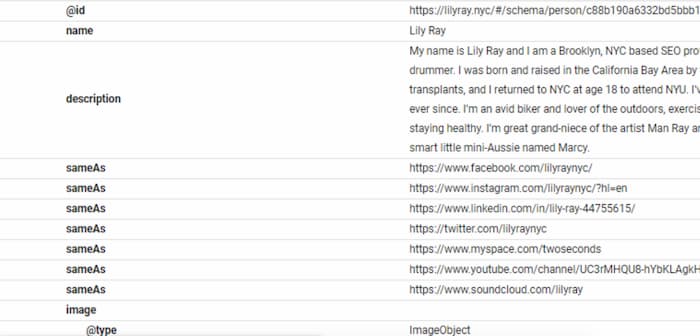
Structure your site for users
Link to your about and contact pages from the navigation bar or footer of your website to make these pages easily found. Structure your website in a way that users can find everything they need to build confidence in your brand.
What’s good for users is also good for search engines. They are and forever will be linked. Websites that provide a high level of user experience are rewarded with high search engine rankings.
At the end of the day, search engines want what’s best for the user. If you can identify what those things are in your niche, you’re able to apply the most accurate principles that satisfy the Google EAT algorithm and positively impact your search visibility.
Video Content Marketing Trends In 2021
The age of video marketing is upon us and in full swing. We’ve already witnessed the rise of video, which can be seen in YouTube’s rapid growth over the last few years.
There are dozens of ways to use video as part of your marketing strategy for 2021 and finding the angle will definitely contribute to additional traffic, conversions and a larger bottom line. Read about the video content marketing trends that are taking the world by storm and which you can capitalize on in 2021.
Ephemeral content
By definition, ephemeral content expires within a certain time period. The angle is to play on the user’s FOMO (fear of missing out) in order to elicit an immediate response or action. This type of content is being used more and more by marketers because of its effectiveness in getting attention. Stories have increased the time users spend on social media from 15-32 minutes a day.
For those who are dabbling in the world of influencer marketing, ephemeral content can be a less expensive way to get your content in front of an influencer’s audience. Many influencers on Instagram for example, will charge less for a story (that lasts 24 hours) than an actual post on their profile.
Ephemeral content provides an accurate way of measuring the impact of an influencer’s audience. The short bursts of increases in traffic and conversions can be attributed to the influencer campaign, giving investors more accurate insight into the value of influencer marketing.
Webinars
As a growing form of video marketing Webinars provide an effective method of educating an audience while providing a personalized touch (in your live stream events). Communication webinars have a conversion rate of 67%.
This marketing tool combines the concept of building authority and the confidence of your audience by educating them about a specific topic. Many webinars aim to sell products focus on showing their audience how to solve a specific problem using their product. With a first hand glimpse at what the product can do, there’s a much higher likelihood that users will buy the product.
Webinars can be extremely informative and therefore repurposed into more bite-sized chunks of content to include in your marketing campaigns.
The best webinar software allows you to schedule users to watch the replay multiple times throughout the day to continue driving traffic and generating leads.
Google search results
If you’ve been paying attention, you may have noticed an increase in the number of videos that appear in the search results. Apart from the fact that Google owns YouTube (which means 95% of the videos are YouTube videos), there is a growing demand for video content that Google is supplying wherever possible.
Videos are appearing in searches in which the underlying user intent may be satisfied with a video. Take product searches for example. Many times a video will appear as a product review or a video on how to use the product.
Considering the fact that entire business models are built on YouTube traffic suggests that there is a massive opportunity. The first-page position on Google, as well as a high-ranking position on YouTube, can contribute to massive traffic to a website or conversion page.
There is evidence that incorporating a video on web pages will also contribute to a higher ranking on Google.
How to capitalize on more traffic from video
Obviously, creating a video is your first step. Many companies are under the impression that it takes a large investment to create a video content marketing campaign. Bentley proved this theory wrong by shooting an entire promotion with an iPhone.
Optimize your videos for SEO
Although a video has the potential to go viral or be shared enough to drive a substantial amount of traffic, optimizing your video can get your content in front of a targeted audience.
Use the basic rules of on-page optimization by including your keyword in the title, filename, description and tags.
Take your video SEO to the next level by publishing a transcript of your video within the description. The more information you give search engines about what’s on your video, the more keywords your video can appear for in searches.
Include chapters to increase appearances for video snippets
A simple way to segment your video into pieces is to create chapters. Write out the times on your video that represents where topics change or where questions are answered in order for search engines to pick up on your snippet.
Simply include the segments of your video in the description with a time next to each chapter.
YouTube will pick up on the markings and segment the progress bar into the different pieces of content that you’ve highlighted.
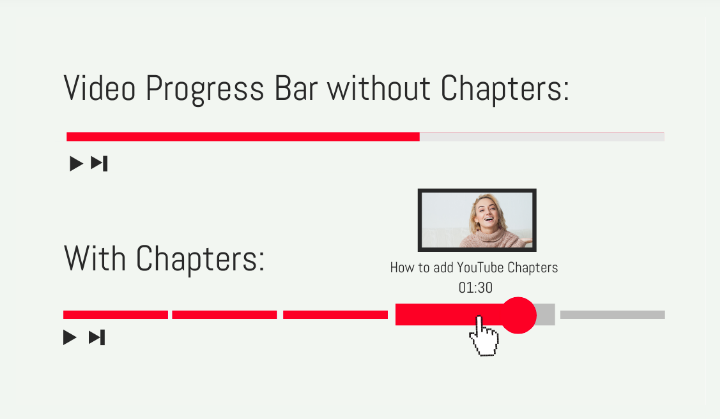
This results in providing search engines with more accurate information that can be highlighted for appropriate search queries. The segmentation of video content creates smaller snippets of specific information that is shown more frequently in keyword-related searches.
The reach of OTT
Video streaming has already been a major movement that has caused many families to switch from cable to streaming platforms. It is estimated that 87% of families now stream to their televisions and of those, 70% no longer use cable.
YouTube is one of the largest platforms with far-reaching implications. If you’re going to advertise using a PPC campaign, it’s an obvious choice to consider. The challenge becomes being able to target your ads and make sure it’s reaching an appropriate audience.
Video marketing trends are too big to ignore
The world is changing, as we know it. Video has provided us with an easy way of creating content and is now the preferred method of content consumption. With the numbers continuing to rise, it’s obvious that if you’re not including video content marketing in your overall marketing strategy, you’re leaving a lot of money on the table.
Look to use the most appropriate video content marketing trends that apply to your business. The effort you put in now will only contribute to higher margins, more leads and increased revenue.
14 SEO Myths To Eliminate For 2021
When you look at the bigger picture, the internet is still in its infancy. We’ve seen many drastic changes since Google emerged as the dominant search engine and they continue to make changes to its algorithm daily. Every so often algorithm changes can shake up the entire SEO industry. Constant turnover in what works and what doesn’t can give birth to SEO myths and cause them to circulate.
The truth is that Google’s algorithm is proprietary, making it impossible for anyone other than Google to know with 100% certainty how exactly it operates. Much of what we do know has come from large amounts of data and results in which we have drawn our own conclusions.
To this end, many people are still catching up with the times and are only now learning what search engine optimization entails. With so many years of changes, it makes sense that there are a lot of SEO myths circulating. This article will bust a few of these SEO myths so you can count on creating a reliable SEO strategy for 2021.
- Anyone can do SEO.
- SEO is primarily about keyword optimization.
- More links are better than more content.
- Longer content ranks higher.
- There’s a secret SEO recipe that ranks your website.
- SEO is a “one-time” operation.
- A guaranteed #1 position on the first page of Google.
- It’s better to hire an SEO company in your city.
- Cheap SEO services save you money.
- All backlinks are created equal.
- More website traffic means more revenue.
- You need exact match keywords to rank highly.
- Syndicate content gets you penalized.
- All SEO companies offer the same product.
#1-“Anyone can do SEO.”
The belief that anyone can do SEO is true in the sense that you could say “Anyone can be a doctor.” Sure, if you work hard, study hard and learn what you need to know, you can become anything you want to become. But if you think that an untrained and inexperienced individual is as capable as an SEO professional, this is a big fat SEO myth.
Anyone can learn SEO and at a basic level, understand the concepts and even apply the fundamentals of search engine optimization. Like any skill you practice, there is a learning curve to expect where you’re guaranteed to make mistakes and encounter situations that only experience and knowledge can solve.
Google recommends using SEO consultants
When you’re working on a website that earns you money, some things are best left to the professionals. Google itself recommends that every website owner at least consult with a professional.

There are mistakes that an inexperienced person can make that will cost your business more than it would to hire a professional in the first place.
For example, link building can be extremely dangerous if you’re not following Google’s best practices and guidelines. If you’re using the same words as anchor text to link to your pages, you may wind up beyond page 10 of the search results due to an algorithmic filter penalty.
Optimize your earning potential
Navigating around potential disasters is only one side of the equation. The other aspect of hiring an experienced SEO expert is that they know how to get the most out of your website. SEO is a continuous effort where making small adjustments for a few percentages more here and there add up to a lot of extra revenue.
For example, if you knew how to create a rich result you might be able to increase the click-through rate by a few percentage points. If your keyword gets thousands of searches a month, this translates into an enormous amount of additional revenue.
Luca Tagliaferro published his case study on the difference in click-through rate when adding a FAQ rich result to one of his pages. A small snippet resulted in 1.5 times as many clicks.
Hire specialists to get the best results
You wouldn’t ask your local butcher to get rid of a mole on your body just because he’s good with a cleaver.
You ask a specialist to remove it.
In the same way, you wouldn’t ask an IT guy (or web designer for that matter) to come up with an SEO strategy for your business. They may know a thing or two about SEO but when it comes down to getting the most out of SEO, it is a process best left to the professionals.
#2-“SEO is primarily about keyword optimization.”
This myth could also be phrased as “SEO is all about ranking” or “SEO is primarily about lead generation.” The truth is SEO encompasses a large segment of digital marketing. Most people don’t realize how far-reaching SEO is when it comes to anything search engines, making this statement a complete and utter SEO myth.
So what exactly is SEO? Search engine optimization is the process of making a web-property more likely to be displayed by a search engine for a specific search query. SEO is not just about ranking, lead generation, or keyword optimization.
It includes competitive analysis, technical improvements, conversion rate optimization, keyword research, link building, public relations, networking, revenue generation, content creation, on-site and off-site optimization and the list goes on.
SEO plays a role in almost every aspect of generating revenue from your website, social media, content marketing and/or paid advertising.
#3-“More links are better than more content.”
There was a time when the websites that had the most links ranked the highest on Google. Many SEOs reflect on this time as similar to the Wild West era when outlaws were able to get away with breaking the law.
In this period of time, software systems were developed to build thousands of links overnight which made it easy to game the system.
This method of ranking was eliminated by a series of updates (Penguin Update) and technological advances that allowed Google to assess the quality of backlinks.
The quantity of links is no longer the only variable in the ranking equation.
What is true is that the more quality links you have the more authority your pages gain.
The key phrase here is quality.
If there are any unnatural links or irrelevant links, they are ignored. If there is an excess of poor quality links, the authority and trustworthiness of your website is devalued.
This is reflected in your ranking and overall search visibility.
Content is still king
If your content is written for users and gets a good level of engagement, the backlinks will come naturally. If you campaign to acquire backlinks to good content, the process is much easier and faster.
It’s better to have more quality content on your site that users are reading through than it is to have backlinks to poorly written pages. At the end of the day, even if your pages manage to make it to the first page of Google because of your backlinks, it won’t stay there for long if your content doesn’t answer search intent.
#4-“Long-form content ranks higher than short-form content.”
One misconception in how to publish content that outperforms what’s ranking is to make it longer than the competing pages. The truth is that word count is not what makes a piece of content outperform another. In fact, word count isn’t a ranking factor at all.
Why would a search engine use word count as a metric?
— 🍌 John 🍌 (@JohnMu) August 31, 2020
What lends merit to this notion is that in creating a longer piece of content, you are forced to go deeper into detail or cover more topics within the page. Depending on your keyword, the more information you’re able to provide to your audience, the better you’re able to satisfy search intent.
The ability to satisfy search intent is what search engines will value the most when displaying search results. If the search query is an informational search that has multiple levels of depth to the answer, then creating a more detailed article will result in a higher ranking.
On the flip side of the coin, if the search query does not require depth to satisfy search intent, then creating a longer article would be an exercise in futility.
Why this myth is so confusing
The general trend that has become the norm is that content is becoming longer. The average first page search result is 1890 words.
There is evidence that Google values depth, but it must be taken in stride with what the intent of the user is when performing the query. It is not word count specifically that determines whether a page is better quality, but the ability to satisfy the users intent of the search.
#5-“There’s a secret recipe to rank a website.”
Many people have the belief that there is a secret sauce or some sort of magic bullet that will rank a website. SEO is quite the opposite in regards to transparency. There are no secrets when it comes to traffic generation or improving search visibility.
Transparency offers the best value
The best SEO consultants can break down an SEO strategy so that it makes sense to the client. The concept of search engine optimization in its simplest form is to create great content that users are searching for and make sure search engines can find that content for specific search terms.
The strategies and tactics that work for long-lasting results are not secrets. Anything that sounds like a magic bullet should be ignored since there is a shelf life for stuff like that-which usually falls into the realm of black hat SEO.
Practice white hat SEO
White hat SEO is the practice of adhering to Google’s best practices when developing a website. Link building is best done through any means that allows a webpage to accumulate natural and high-quality backlinks.
There’s no substitute for producing quality content and natural link building.
Anything else is short lived and could ruin the quality of your website.
#6-“SEO is a “one-time” operation.”
Many people are confused about the process of SEO and what it actually does over time. It’s common to hear someone ask to have their site optimized thinking it will be a one-time job.
This a complete SEO myth! The SEO process is multilayered and multidimensional.
On-page optimization is one of a few different aspects in developing a website’s content to drive traffic. There are four large groups you can label as part of the SEO process for developing content; keyword research, content creation on-page optimization and link building.
It took Ahrefs four years to build their blog to drive massive traffic. They were able to achieve such huge success in driving traffic by publishing top-notch, evergreen content and then ranking it to the top of the search results.

That doesn’t even touch on the technical side of SEO to produce and maintain a high functioning website.
And we haven’t mentioned the monitoring and tracking side of SEO that incrementally improves search visibility, quality of traffic and conversions.
SEO is far from a one and done operation and is nothing short of a long term investment.
#7-“A 100% guarantee to rank in the #1 position on Google.”
Let’s start by saying that unless you own Google, it’s impossible to guarantee the #1 position with 100% certainty. Search engines are changing all the time and no one but Google can account for changes in the algorithm that could result in the rise or fall of a website’s ranking.
Having said that, it’s possible to estimate rankings based on experience within the industry or experience in ranking the keyword itself. A 100% guarantee on a #1 ranking is impossible for anyone who doesn’t control Google, however, a seasoned professional could speculate ranking to a close degree of accuracy-especially if they’ve done it before.
FYI, it’s much easier to estimate entering the top ten results than to guess how long it will take to make your site first on Google.
#8-“It’s better to hire an SEO company in your city.”
The beauty of SEO is that it can be done from anywhere. Digital properties can be accessed and worked on from anywhere in the world. The location of your SEO Company does not matter if they are experienced and good at what they do.
Choose your SEO company for the right reasons
Choosing the right SEO company should be based on several factors such as experience, referrals, results and reputation. If you’re in Toronto and you had the choice of ABC SEO Company Toronto or. Rand Fishkin, The SEO wizard of Moz (he’s a big deal in SEO but based in Seattle if you didn’t know already), who would you choose?
Let me help you with this one-you choose the legend of SEO, Rand Fishkin. Why? Because Rand Fishkin will turn your website into a monster moneymaker. So what if you pay extra money every month. If you knew your earnings would increase by 30% at the end of the year wouldn’t it make sense to invest the money on a sure thing?
Let go of traditional ways of doing business
Location can be beneficial to some people for peace of mind. It’s nice to know you can run and bang on the door of a company if you need to go looking for them. At the end of the day, you should be deciding to hire an SEO company for the right reasons so you’ll never need to bang on their door.
Settle for zoom meetings if you’re the traditional type who likes to meet in person. If you want your business to grow, you also need to grow with the times. Your website lives in a virtual space so distance has no boundaries when it comes to choosing the right company for your business.
#9-“Cheap SEO services save you money.”
Finding the right people to work on your website for the right price is an important factor in making the best decision for your business. There’s no problem in choosing an SEO company that’s less expensive than another but it’s important to note that SEO services aren’t cheap. Choosing an SEO company because they’re offering cheap SEO services could cost you way more in the long run.
You get what you pay for. Be wary of cheap SEO services, as they do not include the same benefits of hiring an SEO company that does all the right things for your site. There are thousands of “SEO professionals” that will offer you prices that are too good to be true. Many of these services will submit your site to low-quality directories or link your site to their private blog network, both of which will ruin your website over time.
These companies can reduce your search visibility and cause more harm to your site than good. There’s no substitute for a professional, accurate website assessment and strategy session with an SEO specialist. Why leave the future of your business in the hands of someone who doesn’t have good references or a strong reputation for getting good results?
If you work with the right SEO company, you will make more money than you would without them. It’s the reason you hire a professional for these services. They make you more money through strategic planning and execution.
There are no shortcuts when it comes to SEO. Make sure your provider is up to par when it comes to putting in the work that will ultimately increase the revenue your website generates.
#10-“All backlinks are created equal.”
To the untrained eye this may seem like the case, however, it couldn’t be further from the truth. Some backlinks will help your website, some backlinks do not affect your website and backlinks that will harm your website. Knowing how to tell the difference can make a huge impact on the search visibility of your website.
For example, imagine you’ve started a small business that develops custom POS software for retail stores. Would you prefer a link to your website from Entrepreneur.com
or from bargainballoons.ca?
First off, Bargain Balloons (yes it’s a real site) isn’t even in your niche. It’s unrelated to your product and therefore a link from them will be ignored. In fact, if you continued to get links from websites like this, your website would start to lose search visibility. Google would downgrade the trustworthiness of your site and push it back in the search results.
A link from Entrepreneur.com however is an incredible link to acquire. Not only is this backlink from a website that specializes in entrepreneurial content, but the audience consists of the exact types of visitors you would want on your site.
A link from Entrepreneur would send other small business owners to your site that in many cases would be interested in your product.
This is the first huge win.
The second is the massive volumes of traffic the site generates. Your site would receive a substantial boost in referral traffic for the life of the article your link is on.
The last huge bonus is that Entrepreneur.com has massive domain authority. A link from them would transfer domain authority to your own site, giving you more ranking ability.
The following image is an visual example of Google’s PageRank theory. It shows how all websites are assigned their own values of PageRank, which Google uses in its ranking algorithm.
All links are definitely not created equal.
Consider the type of website the link is coming from
Another factor to consider is the different types of links that exist. First off, there are followed and nofollow backlinks. A followed link transfers domain authority, a nofollow link does not.
Besides this very important detail is also the issue of where the links are coming from.
A link from a directory will not carry the same weight as a link from another business within your industry. There is a value assigned to a link according to the relative ease in which it can be obtained. Anyone can get a link from a directory, but not everyone can get a business to agree to link to their website.
#11-“More website traffic means more revenue.”
Website traffic alone does not guarantee an increase in revenue. However, more targeted website traffic from high converting keywords will generate more revenue.
For example, imagine you sell men’s athletic wear on your website. If for some reason your website began ranking for the term menswear, it would have mixed results since this keyword has multiple possibilities of intent. Not all users that type this keyword will be looking for athletic clothing.
In fact, if we look at the SERP, it suggests this is a broad category. The first two results are local websites that list the top menswear stores (none of which are specifically athletic).
The majority of the results that appear for this keyword are higher quality casual and formal clothing.
Find the true intent of a keyword
Keyword research is one of the first components of SEO because it helps publishers understand whether the user’s intent for the search will result in a desired action on your website.
Some keywords represent mutliple intentions.
For example, the keyword French press could mean that a user wants to buy a French press, learn how to make coffee using a French press, learn what a french press is exactly and so on.
You can determine a great deal of search intent based on the search engine result page. The Google SERP features indicate intent.
A local pack would mean that people are looking to pick up a French press in their area.
If you see Google Ads appear, it’s an indication that people are making money on this search term because they’re paying to appear in the result.
Videos indicate there is a demand to learn more about a brand or how to do something.
Not all keywords result in an immediate conversion. 80% of keywords are considered to have informational intent. Not everyone who visits your website will buy something when they get there, however, they may become clients at a later date if you’ve established an effective marketing funnel.
When you can optimize your website for keywords that have a specific purpose in your marketing funnel, increasing traffic from those keywords generate more revenue.
Without testing, measuring and tracking your key performance indicators it’s difficult to know how well your website is performing in converting visitors into clients.
#12-“You need exact match keywords to rank highly.”
There is some truth in optimizing content with exact match keywords; however, it isn’t necessary to rank highly. Google ranks pages by keyword topic, not just whether a page has the keyword posted within its content, which makes this statement an SEO myth.
There are millions of examples where Google has ranked a page in the number one position without the page using an exact match keyword. This is because Google understands context and will rank pages according to how well they answer search intent.
Look at the top websites that rank for the term SEO content writing. Only one title in the top 4 results contain the exact match keyword.
If your target keyword is SEO content writing and your article is an ultimate guide on how to produce SEO content, it’s possible to rank for your target keyword because your page shares the same search intent.
Your title could be “How To Produce SEO Content: The Ultimate Guide.” If it’s the best piece of content and offer the most expert SEO writing tips, you’ll rank for the term.
Even if other sites have the exact match keyword within all of the expected places, your content will rank the highest of it is the best match to search intent and offers the highest quality of content.
Does adding an exact match keyword help with on-page optimization?
Yes, absolutely. In fact, it’s considered best practice to optimize your pages for a target keyword in which you would include that keyword in the places search engines use to categorize your content.
Including your exact keyword in the title, URL, image alt tags and within your content will contribute to a highly optimized page with more probability of ranking higher.
#13-“Syndicate content gets you penalized.”
There is a big difference between syndicate content and duplicate content, the latter being the one that gets you penalized. Syndicate content can actually benefit your site by amplifying good content. If the content you syndicate is being read by a lot of visitors on your site, it improves your user engagement metrics-which is a good thing for your ranking.
Take Medium for example. There’s so much content on this site that is directly imported from other websites. It still ranks for a lot of top keywords because it uses the correct method of assigning attribution.
Absolve yourself from all chances of a penalty by placing the correct canonical tags on the content you produce (WordPress does this automatically for you).
Credit the original website as the author for any content you syndicate. Use the `rel=”canonical”` attribute on the anchor tag that links back to the original article. This tells search engines you aren’t the original author, which means you’re not claiming the content as your own.
Where you get into trouble with duplicate content penalties is when you’ve copied another article and published it as your own. If the content is a match to another page-which would have been indexed before yours, your site will experience an algorithmic filter penalty.
Spun content is just as dangerous as duplicate content
The same algorithmic filter kicks in for spun content. If search engines detect that you’re spinning an article that already exists they will demote your page in terms of trust and authority. This is most obviously reflected in search visibility and ranking.
Always give credit where credit is due. If you’re posting someone else’s content, give them the link to attribute them as the original author and avoid the duplicate content penalty.
Your content will then be considered syndicate content, which is a perfectly acceptable practice when proper attribution is given.
#14-“All SEO companies offer the same product.”
Most SEO companies are capable of addressing the major aspects of search engine optimization, however, not all will offer you the same package. Some companies are better at certain things than others. Almost every company will promote the strategy that they’re good at because they know it will get you results.
This doesn’t automatically mean it’s the best strategy for your business. Make sure the company you choose offers a strategy that matches your business and industry. An SEO company might be absolute wizards in PPC campaigns.
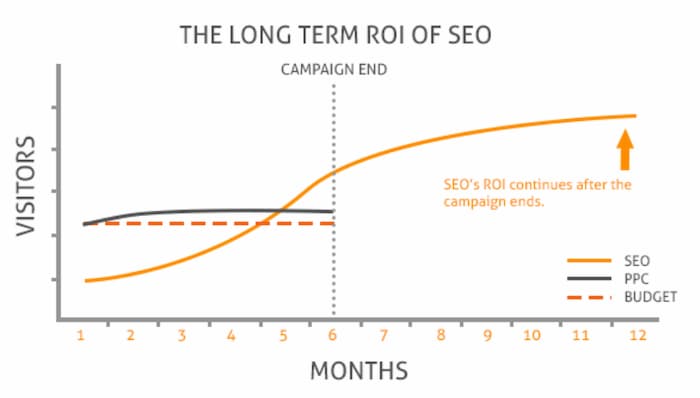
That doesn’t mean it’s the best SEO strategy for your company website even if they get your business turning a profit. You may have bigger opportunities in developing your organic traffic.
It pays to interview three to five different SEO companies before deciding on who to work with.
You will do much better in the long run if you can find an SEO company whose strength lies in a process that is tailored to your operations and offer you the most long term growth.
SEO myths can make or break your strategy
The emergence of SEO myths is an inevitability that should be expected. No one knows what the Google algorithm is with 100% certainty. The truth is it continues to change on a daily basis.
Constant vigilance is required in order to stay on top of the SEO trends that are verified truths as well as the trends that become obsolete. Read industry websites and follow SEO influencers that report major changes to search.
ICYMI: Google is testing people also ask with question mark icons https://t.co/hBXjNAtkkX pic.twitter.com/OlOjspW8Lv
— Barry Schwartz (@rustybrick) December 30, 2020
Being an early adopter to new SEO trends can mean the difference in making thousands of dollars in revenue.
Identifying obsolete practices before you make the mistake of using them can save you an enormous amount of time and resources.
If you have any questions about the validity of an SEO myth that hasn’t been mentioned yet, feel free to contact us via email. We’re happy to share our thoughts.
7 Effective B2B Content Marketing Strategies In 2021
The world as we know it has changed drastically in the last year. There’s been a rise in demand for online services and products in many categories, while a waning demand in others has put more pressure on companies to perform. So where are we at when it comes to providing the most effective B2B content marketing strategies for our clients? Here are a few strategies you can be sure to see a lot of in the upcoming New Year.
Infographics
Visual content has made its mark in the content marketing world and none is so effective in a B2B setting as visualized data. Creating infographics will continue to be an effective B2B content marketing strategy long into the foreseeable future.
Direct marketing strategy
The ability to retain information jumps from 10% to 60% when presenting text with images as opposed to plain text. This makes visual content an obvious choice for companies who want their potential clients to remember important details in a pitch or project proposal.
Generate quality backlinks
Apart from the advantages of using infographics as marketing material, the fact that infographics produce 172% more backlinks than regular text articles makes them a major asset to a company. With more people searching online than ever before, there is more competition vying for important keywords that generate income.
Improved search visibility
Infographics contribute to a healthy backlink profile and can provide streams of traffic once they rank as resources for other amplifiers who publish content in your industry. Journalists, writers and other publishers in your niche will look for statistics, facts and resources to use within their articles. Infographics are an excellent way to provide a resource with visualized data, which is perfect for those in need of citing a resource.
An example of one is the infographic we did on Web Design Trends By Toronto Experts
Video marketing
The rise of video has been an obvious success story over the last three years. YouTube has posted some incredible statistics-more notably becoming the second most popular website in the world (overtaking Facebook). What once was a marketing aid for businesses has now become a full-on business model with engagement statistics through the roof.
Most notable is the B2C market since YouTube is often visited for product reviews and as a way for customers to learn about a product. However, many fail to see the power of video as an effective B2B content marketing strategy despite the overwhelming evidence of how it works to generate more revenue.
Here are five facts that provide evidence of the success B2B video content marketing has and will continue to have throughout 2021.
Expect to see more video infographics appear as companies make more of an effort to get more of their message across via this trending channel. There’s a fine line between maintaining a level of professionalism in terms of the video content you publish for B2B as opposed to B2C. A video infographic allows companies the benefits of the YouTube audience while maintaining a high level of professionalism.
Google feature optimization
The proof has already been laid out for us and as scary as it is, the truth is we are witnessing a decline in the number of clicks that are going to organic search.
As much as this may seem bleak and unpromising, there is a silver lining to this inevitability. Companies can optimize for Google features to counteract the trend of a declining organic click-through rate.
Featured snippets
The most obvious of all Google features is the featured snippet. This is one of the most valuable of all features because it takes the top position on the SERP. The featured snippet is considered position zero-the new first position because it absorbs the bulk of the clicks.
Optimizing for position zero is an effective B2B content marketing strategy because of the value it holds in traffic as well as branding. When your company is listed at the top of the results page as an enriched search result, it brands your company as an industry leader and an expert in its field.
Companies have and will continue to review first page positions they currently hold to optimize content to appear in this position. Winning the snippet can dramatically increase the search visibility of your website and contribute to more leads and revenue.
PAA boxes
The PAA box appears for a significant portion of search results. SEMRush has discovered that when you hold a position in the PAA box, you hold a position for many different variations of that question which can send a significant amount of traffic to your website. These multiple variations of questions that rank in the box are also known as content hubs.
The trend has been to optimize your content into as many snippets as possible. Post more content using tags highlights the information into recognizable chunks (or snippets) for search engines. This makes content more “snippable.”
What does “snippable” mean?
Snippable means to organize content to be recognized more easily by search engines. To make your content snippable leads to more featured results in PAA boxes, passages and featured snippets.
Google passages
If you haven’t noticed already, Google has begun to highlight the text on pages whenever you search for a specific answer to a question. This indicates the level of detail that you can expect in the upcoming era of search.
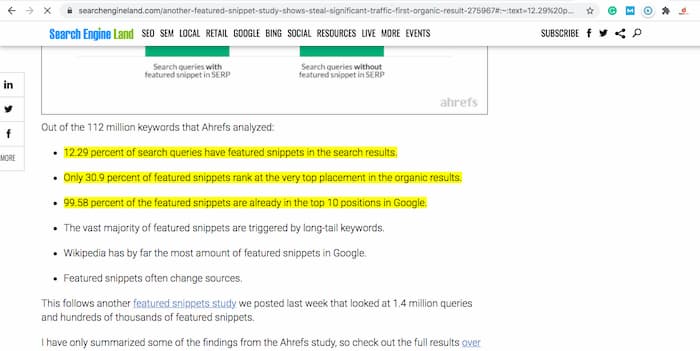
Not only do search engines find the pages with the most suitable content, but they highlight the text within the page that directly answers the question. Google passages provide us with all the more reason to make your content snippable.
Co-marketing projects and partnerships
Expect to see more companies partnering up as a B2B content marketing strategy for specific projects and/or promotions. The advantages of working with another company have a huge impact on expanding your audience and branding your company as an expert in your industry.
Direct marketing advantages
When companies form an alliance for a specific project, they are sharing one of their most valuable resources; their network. All promotions and content will go through the regular channels such as on-site content, off-site content, social media and any email promotional material.
More companies are creating more opportunities by leveraging their partners’ audience in exchange for their own. This symbiotic relationship can be an ideal partnership for those that aren’t direct competitors but share the same industry.
Airline, hotel and car rentals are an excellent example of how companies can team up and combine their efforts to give their customers the best prices.
Some companies aren’t anywhere close to sharing the same industry, yet cross promoting still positively affects their revenue. For example, Volvo became the official car for Legoland.
When you’re able to promote another company within your campaigns it paints a positive light on your brand. It shows you’re not afraid to help your audience find a quality product that you believe will help them in their everyday lives. This can contribute to more trust in your brand and ultimately more brand loyalty, sales and revenue.
Long term advantages
Another aspect to partnering with another company is the additional search visibility for the extended network. Keep in mind that backlinks are one of the largest ranking factors that affect search visibility. Working with another company’s network can result in a brand new audience that comes with more possibilities for link building and sharing.
The additional exposure to another network can give your company a huge advantage over your competitors. The surge in traffic can have a long lasting effect in your rankings from increased backlinks and search visibility.
Personalized email marketing
As one of the oldest, yet most effective forms of digital marketing, personalized email marketing will be a top choice as an effective B2B content marketing strategy.
A simple fact is that the ROI is unparalleled in the industry so it’s impossible to ignore (over 3800% ROI). The difference in creating campaigns that get the most conversions will be how well companies are able to segment lists and personalize content.
We’ve already entered an era where user engagement and personalization reign supreme. In order to make the most of what is already working to generate conversions, companies will need to continue to personalize content in order for it to reach its intended audience.
List automation is old news and in order to avoid the trash section of the inbox, personalized content is the only way to separate your company from the rest of the email campaigns.
On-site content development
The content you produce on-site is going to play a huge part on the search visibility of your website. The development of content that provides value to your audience is crucial for spreading awareness and nurturing leads that convert into sales.
Small businesses can expect to produce more leads regularly from publishing SEO content regularly. In fact, companies that publish 11 times a month get 3.5 times as many leads as companies that publish once or twice a month.
Information is in demand and the means for supplying the specifics to users searches has created benefits for being extremely detailed. The on-site content you produce will play a part in developing the success your website has in the search results and ultimately its performance as a lead generating asset.
Original data and research
Individual data from research, studies and surveys are among the most useful pieces of content you can develop for your company. Identifying what interests your clients is an effective way to publish content that your ideal audience wants to read about.
The more information you have about your clients, the better chances you have for engaging them on more levels. With the proper research, you can build your content strategy on topics that mean the most to your current and future customers.
Research, studies and surveys are excellent tools for developing more insight into what your clients want and how they experience they have using your products. Find out what works and what’s not to provide a better experience with your brand.
To generate original statistics on your findings gives you a foothold in the industry for publishing original data that no other company has access or has ever published. This is an excellent means for creating newsworthy coverage resulting in earned media and the potential of earning high quality backlinks.
Establish a B2B content marketing strategy for 2021
It’s cliche, and yet it remains one of the great truisms in digital marketing: Content IS King. What’s also true is “He who fails to plan, plans to fail.” The takeaway here is that by establishing an effective B2B content marketing strategy for 2021, you will be setting your company up for success.
Use any or all of the strategies above to drive robust traffic to your website and brand your business as industry leaders. The time has come where everything you do to improve your content will pay off in dividends further down the line.
Need help with your B2B content marketing strategy? Let us give you a hand by assessing your website and proposing a game plan to rank your website to the top of the search results.
Organic SEO Vs. PPC: Which Is Better?
It’s impossible to claim whether one form of traffic generation is better than the other. Like so many things in SEO, the truth is, it depends. To debate over organic SEO vs PPC and which is better, you’re going to need to consider a few important factors that go into making the decision on which avenue to pursue.
What is organic traffic generation?
The organic search results are the portion of the search engine result page that is generated based on the websites that have the best answer to a search query. This segment cannot be bought by anyone as the results are generated by the algorithm search engines use to display the best results to a search query.
For this reason, the organic results tend to instill the most confidence in users and attract the most clicks.
What is paid traffic (PPC campaigns) generation?
The top of Google’s search engine result page is typically reserved for 4 four paid results that are marked with the word “Ad” to indicate they are paid placements. Google Ads uses a Pay Per Click model that has been adopted by social media websites and of course, is used by the other search engines as well.
The concept requires you to pay for every click that a user makes to your website when you’re in a paid position on the SERP. This is your cost per click (CPC).
Advantages of organic search engine optimization
- More traffic
- Lower cost
- Continuous
- Adds value
Drive more traffic from organic search results
On average, the organic search results take up 40% of the click on mobile and 60% of the clicks on desktop. It is undoubtedly the largest source of traffic that is available.
People tend to avert advertisements, and will naturally skip over them and click on an organic result because it’s the most unbiased result. Of course, it depends on the type of keyword but for the most part, the organic results win the lion’s share of available clicks.
Lower cost alternative
Although there is still a cost to driving organic traffic, it becomes a fraction of the cost of what you would pay Google for the same traffic in the long run. This is because once you have a page that drives traffic, clicks to your site are free.
The major burden is the cost it takes to rank a page into the top 10 positions. With more traffic flowing abundantly to your website, your cost per acquisition lowers over time.
Provides continuous traffic
Organic traffic is continuous in regards to the fact that once you rank on the first page, you can stay there indefinitely. Even if another website happens to outperform your page, a drop in position does not stop the traffic to your website.
Holding a position on the SERP means driving organic even after you’ve stopped paying for SEO services, whereas with PPC your traffic stops when you stop paying.
Adds depth and value
Organic traffic generation involves publishing content that is being searched and found by users. As your site continues to target and rank for keywords that are important to your business, your website develops authority and depth. This never disappears.
Top keyword rankings for content that people are looking for is a valuable commodity. Your site becomes a resource the more SEO content that you publish for your audience. Therefore, the process for developing organic traffic raises the value of your website by adding depth to the niche-oriented content you publish.
Disadvantages of organic SEO
- Takes longer to generate traffic
- Mostly informational searches
Longer incubation time
There is typically an incubation period for being able to drive organic traffic with new content. The process for keyword research, content creation, optimization and link building can take months before a page begins to drive traffic from the organic results. In a study by Ahrefs of over 2 million websites, they found that the average time for a page to rank in the top 10 positions is over a year.
Only 5.8% of the websites they studied were able to rank on the first page in less than a year, and even so-they average over 2-6 months.
Bottom line is that driving traffic using organic SEO takes time.
Mostly informational searches
Since 80% of the searches made are informational, many of the keywords that are targeted to drive organic traffic typically attract visitors that are not yet ready to buy. This means there is more educating and nurturing the visitor before they can become a qualified lead and new client.
This means that there is more strategy involved for developing a marketing funnel and addressing the various stages of the buyer journey in order to convert visitors to clients.
When should you opt for organic traffic generation?
If you’re building an authority website, you’ll need to build your organic traffic. The content on your website will need to reflect what users are searching for and be the best solution to search intent.
If you’re a local business, you’ll want to build your organic traffic. Optimize to be found in local searches and the local finder.
When you’re invested in your business for the long run, organic traffic generation is the solution. As the highest source of targeted traffic, it will lead to the most revenue at the lowest cost.
Advantages of PPC
- Instant traffic
- Control over audience
- More insight into converting keywords
- Search visibility for competitive keywords
Receive instant traffic
Once you’ve created a PPC campaign you receive instant traffic. It’s not always going to make you money immediately as there is some time required to optimize your campaign. But as soon as you activate your campaign you will be getting clicks to your website from instant search visibility.
Control over your audience
You have the option to select the demographics of your ad campaign. You can literally choose who sees your ads by choosing preferred age, city, times, gender and a whole myriad of options to personalize the audience your ad appears in front of.
Insight into converting keywords
PPC campaigns are an excellent way to conclude what keywords are the best-converting terms for your business. You have access to the behavioural patterns of the users that click on your ad for every keyword within your campaign. This allows you to double down on the search terms that work and get rid of the keywords that don’t convert.
Search visibility on competitive terms
PPC allows your business a fair shot at appearing for search terms that would otherwise be difficult to rank for organically. When the first page of search results is littered with titans like eBay and Walmart, you can bid on those terms to get your product on the first page as well.
Disadvantages
- Higher CPA
- Traffic stops when you stop paying
- Less traffic
- No long term benefits
Higher cost per acquisition
One of the biggest downsides to PPC is it’s considerably more expensive than organic traffic generation. The average cost per acquisition will generally be the same throughout the life of your campaign as opposed to organic traffic which declines over time.
In fact, the CPA could rise should more competition for your keyword decide to join in bidding for the top position.
PPC is not a cheap solution and in many cases it takes money to make money. There is a learning curve to optimizing your campaigns to reduce the cost and increase the revenue you’re making.
Traffic stops when you stop paying
Unlike organic traffic generation, PPC is a pay to play type of format. You have to pay for your position on Google and when you stop paying, so does your lead generation, sales and new clients.
This presents a problem for businesses if the only way to generate leads is through paid traffic. If the price goes up in their niche, this could spell disaster for a company that solely relies on PPC for sales.
No long term benefits
Unlike SEO, PPC does not provide any long-term benefits to a website. With SEO, intrinsic value is constantly being added to the website through researched SEO content. Over time, a website can develop a strong reputation as an expert and authority within its niche.
PPC does not add value to content or alter your website in any way. It is simply a paid position in the search results to get visitors to your website.
When should you invest in pay per click (PPC)?
PPC is good for short-term or one time promotions. When you need traffic fast, PPC is the way to go. PPC can deliver you the traffic immediately from the audience you select.
This makes PPC a good option for companies that are just starting out and need new clients to get the ball rolling.
A new website will need time to develop content and strengthen their search visibility. PPC campaigns can supply the traffic required in the meantime to supplement the lack of search visibility.
Organic SEO used in conjunction with PPC
The best-case scenario is to use organic SEO in conjunction with targeted PPC campaigns. As an aggressive marketing strategy, the two working together should be synergistic in the sense that the data obtained from each PPC campaign can be fed into the SEO strategy.
Having more search visibility is never a bad thing. Even if you’re making less money on PPC than organic SEO, using the two together is simply working to increase your total revenue.
When to debate SEO vs. PPC
The choice between SEO and PPC is not one that you can make without exploring options, assessing your current website development in relation to the competitive landscape.
For example, if you’re in a local market or extremely small niche, you may be able to achieve search visibility with simple DIY SEO tactics within a short amount of time.
In a non-competitive environment, it would make more sense to focus your time and resources on developing your website with targeted SEO content.
However in a more competitive environment, having your website appear in the paid results as well as the organic results could be the right balance that pushes your website to new heights in search traffic and record-breaking revenue.
For more information on how to develop your online strategy, give us a call and we’ll give you our best advice on how to make your business more profitable.
7 Tactics To Improve Your Pay Per Click Marketing Strategy
If you’ve been paying attention to the profit Google has been turning over the years, you may have noticed a trend: They keep making more money. A large portion of the total revenue Google earns is from paid ads. Why not follow suit and make more money by incorporating better tactics to improve your pay per click marketing strategy?
Even though they can be much more expensive than organic traffic generation, businesses continue to invest in paid ads for one simple fact: They make money.
Whether you’re already running PPC campaigns, or you’re considering your first go at it, here are 7 tactics to improve your pay per click marketing strategy to increase the revenue you’re generating from each campaign.
Bid on your brand and the name of popular competing brands
If you break down the intent of a brand search, it’s highly transactional. When someone is searching for a specific brand, they already have a product in mind and are in the buying frame of mind. Bidding on popular brands can put your website in front of a large group of searchers with buyer intent.
The larger brands have caught on to this pay per click marketing strategy and will protect the hijacking of their brand by bidding on their brand name. Search for any large corporate brand and you’ll see their Google Ad taking up the first spot in the search result.
Although this tactic is one of many pay per click strategies that are somewhat well known among the larger brands you can still find loads of opportunities where popular SMBs have failed to capitalize on this knowledge.
Bid on popular competing brands to capitalize on an audience with buyer intent. Don’t forget to bid on your brand and protect the name of your company from being used as a way your competition makes money.
Put 80% of your effort into the headline
The 80/20 rules apply here where your headline counts as the most important part of your advertisement. People are going to click on the headline that captures their attention with the most enticing and relevant message. Use headline tips and strategies to ensure your ad receives a high click-through rate to maximize its potential.
Here are a few to get you started:
Use a number in your headline
The use of a number can attract more attention and interest in your content. People like to know what they’re getting and the use of a number manages expectations-which appeals to most people.
Using an odd number can increase your CTR by up to 20%
Spark emotion within your headline
There have been thousands of tests and studies on the effectiveness of ads and the bottom line to remember is that if your ad can evoke emotion it becomes much more powerful.
Here is a list of the top emotions that seem to have a positive effect on the way people respond to ads:
The most successful ads that go viral seem to be those that target humour and are amusing to people. They get shared and spark interest.
Snickers, launched their campaign “You’re not you when you’re hungry” and targeted misspelled words. In just two days they reported over 550k impressions with a CTR of just over 1%. The result was over 5000 people landing on their mini-website in just 48 hours.
The type of emotion you evoke depends on the niche that you’re trying to promote. If you’re advertising for a funeral home, there’s going to be a big difference in your tone than if you were promoting a kid’s event space.
Knowing your audience is a crucial aspect in determining the emotion of your target. Keep in mind that people respond with much more energy when you’ve triggered an emotional response.
Dynamic keyword insertion
Google, Yahoo and Microsoft offer this advanced feature to allow your ads more flexibility by inserting related keywords depending on the search.

For example, if you sell tennis equipment, you may have an advertisement for tennis racquets. You can initialize dynamic keyword insertion by inserting the code:
{KeyWord: Tennis Racquets}
This will then tell the search engine to insert the most appropriate keywords in your ad according to what the user is searching.
If a user searches “kids tennis racquets” or “adult tennis racquets” or “club level tennis racquets” those keywords will be inserted into your ad to make it more relevant to the searcher.
If there are no relatable substitutes, your ad will be displayed with your primary keyword, which in this case would be tennis racquets.
Dynamic insertion contributes to higher click-through rates by creating more relevance to the user’s search.
Use retargeting pixels
Retargeting is one of the best ways to reduce your cost per click because of its success in increasing conversions. This tactic is highly effective in promoting a higher conversion rate because your ad will reappear in front of users that have shown interest by clicking on your ad and landing on your website.
The retail industry, on average, requires 6-8 touchpoints before making a sale. When you have an ad following a user for an additional 8-12 times it gives your brand more exposure and more opportunities to remind the user about your product or service.
How does it work?
You need to install a pixel on your website that you receive from your ad campaign. Whenever a user lands on your site, a cookie is uploaded into their browser. That cookie reactivates the ad within the display network for however many times you choose to set it for in your campaign.
Use a landing page to personalize your campaign
Always use a landing page to personalize your PPC campaign to increase conversions and address a specific need that your ad is promoting.
Many businesses make the mistake of sending a user to their homepage from an ad and leave it to the visitor to find what they need. Rather than take the risk they don’t find what they need, send them directly to the page that has exactly what they need.

Always eliminate clicks and unnecessary obstacles that get in the way of a visitor finding what they want and purchasing it. Navigation to your product should already be done for the user so there’s nothing left to chance.
A landing page gives you a way to warm your visitor up with information about your product and guide them to a purchase decision.
Provide social proof in your copy
We live in a time where reviews count for a huge part of the decision making process for many different industries. People will read the reviews on Yelp before picking a new place to eat dinner. There’s value in having social evidence of the value your business represents.
Include social proof in your copy to promote more clicks to your site. People will be more inclined to trust a company that can show how many clients they’ve already helped solve problems with their product.
Having 5-star reviews with customers raving about how good your food is will bring in more eager customers who want to see what other people are talking about.
Use Google’s Smart Bidding system
You can automate your bidding strategy by using Google’s Smart Bidding system to increase conversions, ROAS and reduce CPA. The system is a combination of AI and machine learning that is effective at predicting trends and tendencies of users to increase the likelihood of making a conversion.
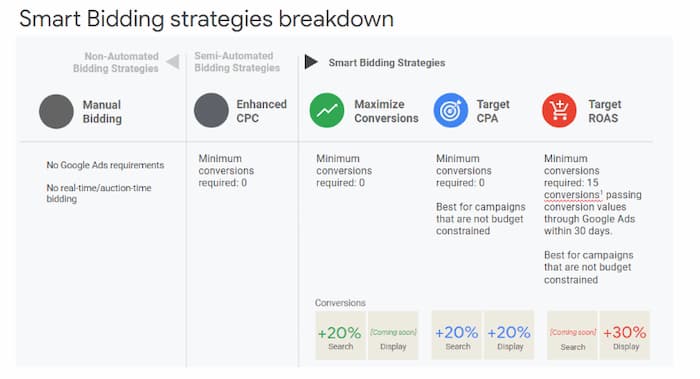
Use Smart bidding to get the best times to bid, the amount to bid and other areas that are automated based on machine learning. Automating the way you run your PPC campaigns with Smart Bidding leads to conversion rate optimization as well as reducing the cost per acquisition over time.
Google suggests running a Smart Bidding strategy for at least 30 conversions or one month to get the full benefits of machine learning applied to your campaign.
Incorporate PPC Strategies to Increase Conversions
There are many pros and cons to using a PPC campaign within your digital marketing strategy, but the bottom line is that they make money. There’s no substitute for getting your brand at the top of the page for important keywords.
If you compare organic traffic generation to pay per click campaigns, organic has more potential with less cost in the long run. However, using a combination of both can make your digital marketing campaign even more profitable.
Incorporate proven tactics to improve your pay per click marketing strategy to increase conversions, lower costs and boost your revenue for every campaign you run.
Want to hear more about how we can help your business generate more revenue? Give us a call and let us give you a breakdown of the opportunities available to your website.
6 Tips To Increase Conversion Rates On Your Website
It’s one thing to get visitors to your site but what’s the point of driving traffic if the visitors don’t end up buying a product or subscribing to your mailing list? The goal of driving high volumes of traffic to your website is to increase the revenue your website generates. This article will give you a few tips on how to increase conversion rates, which leads to new clients, subscribers and ultimately more sales.
What are conversion rates?
A conversion rate is the percentage of visitors that perform a desired action on your website. The action can be whatever you decide is the ultimate goal for your traffic. For instance, if you were selling products a conversion would be when a visitor purchases one of your products.
If 1000 visitors visit your website and 50 visitors make a purchase, your conversion rate is 5%.
50/1000=0.05
Conversions don’t necessarily need to be a purchase. You could also set up conversion goals of acquiring contact information.
If a visitor subscribes to your mailing list this can also be considered a conversion.
If your website is set up for AdSense, a conversion would be for a visitor to click on one of the ads on your pages. This would be the most desirable result when you’re getting paid for every click someone makes on advertisement on your website.

You can set up multiple conversion goals for your visitors as well as track the results using Google Analytics.
Once you have your conversion goals in place, you can see where your pages succeed in guiding visitors to making the most conversions.
Use the following tips to increase conversions rates on your website.
Use an effective call to action
Never assume that your visitors know exactly what to do on your website. Make it very clear for users what the next steps are to move forward in making a conversion.
For example, if you’re in the service industry let them know how they can get personalized help using your services by clicking the button to call your business at the end of every article.
Gently urge your users to complete the desired action. If you want people to like or share your article on social media, you need to ask them to do so at the end in a clear and polite way.
If you want your visitors to sign up for your email list, there needs to be a call to action to guide them into doing so. If the only text your opt-in box has is “Name” and “email address” why would anyone enter their information?
There has to be a message that urges visitors to fill out your form. Using an effective call to action is an absolute necessity to increase conversion rates on your website.
Internal linking strategy
The internal linking strategy implemented on your website can directly affect your conversion rate. Internal links are a great way to guide visitors through related content within your site. Not only can you get more content in front of your audience, but you can guide them to the pages that convert at the highest rate.
You should already be tracking the conversion rates of your pages on Google Analytics or your analytic tracking software of your choice.
Identify the pages that are converting at the highest rates. You can do this by going to behaviour, Site content, All pages.
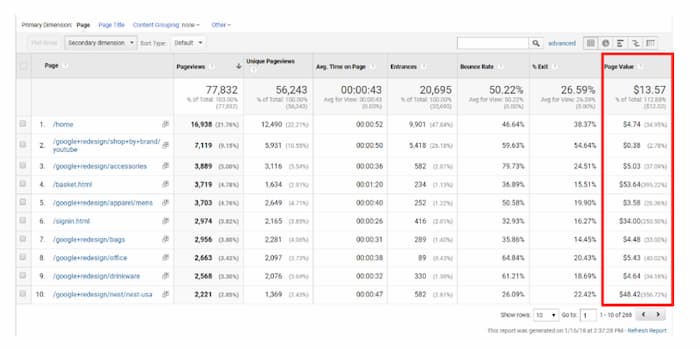
Filter the pages to list the page value starting at the largest amount to the lowest.
Make it a priority to link to these pages whenever possible. Guide users to these pages by using editorial links to hint at the pages they may be interested in.
You can also give users the option at the end of an article to visit the pages that they would also be interested in reading.
The more opportunities you give visitors to get to the pages that convert at high rates, the higher you’ll increase conversion rates will be from your total volume of traffic.
Page load time
The time it takes your pages to load has a direct impact on your bounce rate. It’s been proven that visitors will back off of your page at an alarmingly high rate when your page speed begins to exceed 3 seconds of load time.
By increasing your page speed, you can retain a large percentage of the visitors that land on your website. The lower your bounce rate, the more visitors will have a chance to go through your content.
This ultimately leads to increase conversion rates when a larger percentage of your total volume of traffic is actually getting to the pages you want them to see. Reducing the number of people you lose to slow load time increases the conversion rates.
Email reminders for abandoned carts
Did you know you can increase your conversion rate by up to 69% by sending up to 3 email reminders to those who have abandoned their carts?!
Imagine, a user finds your site, they read your content, they research options and they choose your product, and are filling out the purchase information and they suddenly get called to work or dinner or their kid pukes all over their office.
These are users who have already decided to purchase your product but life just got in the way for whatever reason.
Email reminders are the best way to keep your company in mind and get them back to your site to finish checking out. This strategy is definitely one to incorporate in your email marketing.
Send email reminders on a set schedule for anyone who leaves a cart abandoned to get them back on track to finishing the check out process.
Make things happen ASAP (as simple as possible)
In order to increase conversions make the process as easy as possible by eliminating the number of things a user must do to complete a conversion. Reducing the number of obstacles that stand in the way of completing a goal will increase conversions to your site.
Leadpages found that by making a single field for an email address rather than a field for name plus email address, increased conversions by 12.44%. The concept is simple enough to understand; People are less likely to fill out long forms than they are to fill out short ones.
The less effort it is for someone to give you their contact info, the easier it is to entice them to fill out the form.
Amazon realized this and had massive success with their one-click ordering system. When you can order a product with minimal steps, there are more people that will make it through the conversion process.
Although it may be easier for companies to have a user’s information on file for repeat orders and even a history of products purchased, the option to purchase as a guest will increase the number of conversions made by new clients.
Allowing users to avoid a lengthy account set up before buying a product speeds the process up which means less chances of interrupting the conversion process.
Make your conversion process as simple as possible to see more goals completed on-site.
Use split testing to identify preferences
It’s hard to know exactly what the majority of your users prefer without split testing the options you have available. Simple things on your site such as colours, headlines and placement of features can increase conversion rates on your website.
Leadpages found that when they changed the colour of their button from orange to green that conversion rates went up 86.41%.
Split testing can uncover certain patterns or tendencies of your users that result in more desired actions on your website.
Use split tests for everything you can get your hands on. Test headlines for your landing pages to see whether the users that end up clicking are more likely to convert.
Test the placement of buttons, the background colour of optin forms, the images on optim forms the text that you use as a call to action. Literally everything that can be interchangeable in design has the potential of increasing your conversion rates.
Improve conversion rates for increased revenue
Increase the revenue your website generates by improving the way it influences users to perform your desired action.
In an increasingly competitive search environment, improving conversion rates is an effective way to continually improve the efficiency of your website. Increasing your conversion rates are a way to make more money from your website without the wait time for content to rank for a keyword.
Follow these tips for better conversion rates from your website for increased revenue from new clients.
Don’t have time to do it yourself? Click here to speak with an SEO consultant to learn more about how we generate more revenue for our clients.


